- Digital Marketing
- Apps & Website


How VR Tourism is Revolutionizing Travel Experiences

- Key Takeaways
In 2024, Statista reported a 30% increase in VR tourism adoption, highlighting its growing popularity.
Gartner predicts that by 2025, 50% of global travel agencies will use VR for showcasing destinations.
According to SEMrush, searches for VR travel experiences rose by 40% in the past year, indicating rising consumer interest.
Sustainable travel is promoted through virtual experiences, reducing environmental impacts.
VR tourism is like a magic carpet for travel. It uses fancy technology to take us to cool places and famous landmarks without leaving home. This new way of traveling, thanks to virtual reality, opens up a whole new world for us to explore. Now, we can climb Everest or walk around Tokyo from our sofas, without worrying about money, distance, or harming the environment. As we step into this exciting new world, we wonder: How will VR change the way we travel in the future?
Introduction to VR Tourism
Virtual Reality (VR) tourism changes how we travel by letting us explore the world digitally in 3D. It’s like going on a trip using special goggles that show you different places. With VR, you can see cities, nature, and cool spots as if you’re really there. Lots of people are getting into this new way of traveling, especially those who want new adventures or can’t travel easily.
- Concept of VR Tourism
VR tourism uses virtual reality tech to make fake worlds for people to play in. In travel, it lets you visit fake versions of real places, like Egypt’s pyramids or New York City streets, without leaving your home. It’s not just looking around; you can also do things like take tours, learn stuff, and even go on adventures, which makes it super fun and interesting.
- Impact on the Travel Industry
- Market expansion: Opens up travel experiences to a wider audience, including those unable to travel physically.
- Marketing tool: Provides a “try before you buy” experience for potential tourists.
- Future potential: Continues to evolve, offering more advanced and interactive travel experiences.
Immersive Destination Experiences
- Virtual tours of famous landmarks
- Highly Detailed Visuals : VR tours provide high-resolution imagery and 360-degree views, offering a lifelike experience of visiting famous landmarks like the Eiffel Tower or the Grand Canyon.
- Interactive Elements : Users can often interact with the environment, such as clicking on specific points to learn more about the history or significance of the site.
- Global Access : People from anywhere in the world can visit these landmarks virtually, eliminating the need for travel and making global landmarks accessible to a wider audience.
- Cultural and educational experiences
- Learning and Engagement : VR allows for immersive educational experiences, teaching users about the history, art, and culture of different locations without the need for physical presence.
- Language and Customs : Virtual tours can include language lessons and cultural etiquette, preparing visitors for future physical trips or simply enriching their knowledge.
- Museum and Gallery Tours : Many museums and galleries now offer VR tours, allowing users to explore exhibits and collections in detail, often with expert commentary.
- Adventure and exploration in VR
- Simulated Adventures: Users can try out cool virtual adventures like going on safaris, diving deep into the sea, or climbing mountains. They get to feel the excitement of these activities from home, all safe and easy.
- Interactive Exploration: Adventure VR games let you do fun stuff like solving puzzles and exploring virtual worlds. This makes the games more exciting and keeps you hooked.
- Realistic Experiences: VR tech is getting better, making these adventures feel super real. You’ll feel like you’re really there, having a blast just like in real life.
Technology Behind VR Tourism
- VR Headsets and Equipment
- Variety of Devices : VR tourism is powered by various headsets like Oculus Rift, HTC Vive, and PlayStation VR. Each offers unique features suited for different VR experiences.
- Sensory Immersion : These headsets come with advanced sensors and tracking capabilities to provide a fully immersive experience. They track head movements, allowing users to look around a virtual environment as if they were physically there.
- Enhanced Visuals and Audio : High-resolution displays and spatial audio technology create a realistic and engaging virtual environment, making virtual tours more lifelike.
- Integration with AR and AI
- Augmented Reality (AR) Enhancements : AR adds layers of information to the real world, enhancing VR tours with interactive elements like historical facts, directional cues, or storytelling.
- AI Personalization : Artificial Intelligence (AI) tailors the VR experience to individual preferences, adjusting the content based on user behavior and interests. This makes virtual tours more relevant and engaging.
- Combined AR and AI : Integrating AR and AI with VR can create dynamic and interactive experiences that adapt in real-time, providing personalized guidance and information during virtual tours.
- Future Technological Advancements
- More Realistic VR: VR tech is getting better at making virtual worlds look and feel more real, with nicer graphics and easier ways to interact.
- Wearable Tech in VR: VR is teaming up with wearable gadgets to make things even cooler, like feeling stuff in the virtual world or making it feel like you’re really in different weather.
- Easier to Get into VR: As VR gets fancier, it’s also becoming cheaper and easier to use, so more people can try out virtual tourism. XR Experiences: There’s a new thing called XR that mixes VR, AR, and MR. It’s making virtual trips even cooler by blending real and digital worlds.
Marketing and Business Impact
- Reinventing Marketing Strategies in Tourism
- VR technology is transforming tourism marketing by enabling immersive storytelling and interactive experiences. This approach captivates potential travelers more effectively than traditional media.
- Companies like Thomas Cook have used VR to offer “try before you buy” experiences, leading to a significant increase in bookings. For instance, after introducing a VR experience of New York, the company reported a 190% rise in bookings for the city.
- Destination marketing organizations are also adopting VR to showcase attractions, landscapes, and experiences in a compelling way, enhancing their promotional efforts and attracting more tourists.
- Economic Benefits and Revenue Generation
- VR tourism creates new revenue streams for travel companies by offering virtual experiences that can be monetized. These experiences appeal to a broad audience, including those unable to travel physically.
- It reduces marketing costs and increases efficiency. Instead of spending on physical brochures and displays, companies invest in VR content that can be used repeatedly across various platforms.
- VR experiences can drive actual visits and bookings, as potential travelers are more likely to book a trip after experiencing a destination virtually.
- Case Studies of Successful VR Tourism Projects
- Marriott International launched the “VRoom Service,” allowing guests to order virtual travel experiences to their hotel rooms, enhancing guest satisfaction and positioning Marriott as an innovative leader in the hotel industry.
- The British Museum partnered with Samsung to create a virtual reality tour of the museum, attracting a global audience and enhancing educational outreach.
- Tourism Australia launched a VR campaign to showcase the country’s unique landscapes and wildlife, resulting in increased interest and tourism from international markets. This campaign leveraged VR to present Australia’s diverse attractions in an engaging and immersive manner.
Sustainable and Accessible Travel
- Reducing carbon footprint and environmental impact
- Virtual Exploration: VR tourism allows travelers to explore destinations virtually, reducing the need for physical travel and thus lowering carbon emissions associated with transportation, especially air travel.
- Educational Impact: By simulating real-world environments, VR can raise awareness about the environmental impacts of tourism, educating users on sustainability and conservation.
- Event Alternatives: VR can host virtual events and conferences, reducing the need for physical attendance and the associated environmental footprint of large gatherings.
- Making travel accessible to all
- Overcoming Physical Limitations: VR tourism opens up travel experiences to people with mobility issues, financial constraints, or other barriers that prevent physical travel.
- Economic Inclusivity: By providing a cost-effective way to experience new places, VR helps democratize travel, making it possible for a broader audience to explore the world.
- Cultural Accessibility: VR can bring cultural experiences and heritage sites to users worldwide, ensuring that even remote or restricted areas are accessible to all, preserving cultural heritage and promoting global understanding.
- Preserving natural sites and heritage
- Virtual Conservation: VR can help in the preservation of natural sites and heritage by providing an alternative to physical visitation, which can lead to over-tourism and degradation of sensitive environments.
- Awareness and Education: Through immersive experiences, VR can educate visitors about the importance of conservation and the challenges faced by natural and historical sites.
- Support for Conservation Efforts: Revenue generated from VR tourism can be channeled back into conservation and preservation efforts, supporting the maintenance and protection of natural and cultural heritage sites.
Personalization and Customer Experience
- Tailored travel experiences through VR
- VR allows travel companies to create customized experiences based on user preferences and past behavior.
- Travelers can explore destinations, activities, and accommodations virtually before making decisions, ensuring their travel plan aligns with their interests and desires.
- VR can simulate different scenarios within a travel destination, such as weather conditions, crowd sizes, and time of day, giving a comprehensive preview of what to expect.
- Enhancing customer engagement and satisfaction
- Interactive VR experiences engage customers more deeply than traditional travel brochures or websites.
- Users can virtually visit locations, leading to increased excitement and anticipation for the actual trip, enhancing overall satisfaction with the travel planning process.
- Feedback mechanisms within VR platforms can help companies improve offerings and customize user experiences, leading to higher levels of customer satisfaction and engagement.
- Building brand loyalty and trust
- By providing immersive and personalized VR experiences, travel companies can create memorable interactions that foster brand loyalty.
- Transparent previews of travel services and destinations build trust, as customers feel more confident in their travel choices and the authenticity of what is being offered.
- Regular updates and new VR content can keep customers engaged with the brand, encouraging repeat business and referrals to others, thus strengthening brand loyalty and trust over time.
Future of VR Tourism
- Emerging Trends and Potential Growth Areas
The future of VR tourism looks bright! As technology gets better, VR experiences feel more real, pulling in more people. New trends include super-realistic simulations that let you feel, touch, and even smell places you visit.
VR might also branch out into education, offering fun ways to learn about history and nature. And when VR teams up with AI, it can suggest trips and activities tailored just for you, based on what you like and have done before.
- Challenges and Considerations for the Future
Despite the promising prospects of VR tourism, several challenges and considerations need addressing. Digital divide is a big problem. Not everyone can use VR because it costs a lot and needs good tech. VR should not replace real travel, just make it better. We need diverse VR content about different places. This needs a lot of money for making content and better tech.
- The Role of VR in Post-Pandemic Travel Recovery
Virtual reality (VR) travel has helped the travel industry bounce back after the pandemic. It gives people a safe way to explore new places without actually traveling. When international travel was restricted, VR let tourists visit destinations from their homes, keeping interest in travel alive and helping the industry stay afloat.
Virtual reality (VR) tourism is like going on trips without leaving your home. You use special tech to see and feel like you’re really there. It’s good for the environment because it cuts down on pollution from traveling. VR teams up with augmented reality (AR) and artificial intelligence (AI) to make the experience more personal and fun. As this tech improves, it will change how we travel, making it simpler for everyone to explore while also being kinder to the planet.
Q. What is VR tourism?
VR tourism uses virtual reality technology to create immersive travel experiences, allowing users to explore destinations virtually without physical travel.
Q. How does VR tourism benefit the travel industry?
VR tourism offers innovative marketing tools, generates new revenue streams, and enhances customer engagement by providing immersive previews of destinations.
Q. Can VR tourism contribute to sustainable travel?
Yes, VR tourism promotes sustainability by reducing the need for physical travel, thus lowering carbon emissions and preserving natural and cultural sites.
State of Technology 2024
Humanity's Quantum Leap Forward
Explore 'State of Technology 2024' for strategic insights into 7 emerging technologies reshaping 10 critical industries. Dive into sector-wide transformations and global tech dynamics, offering critical analysis for tech leaders and enthusiasts alike, on how to navigate the future's technology landscape.
- Data and AI Services
With a Foundation of 1,900+ Projects, Offered by Over 1500+ Digital Agencies, EMB Excels in offering Advanced AI Solutions. Our expertise lies in providing a comprehensive suite of services designed to build your robust and scalable digital transformation journey.
Q. What technologies are integrated with VR in tourism?
VR in tourism is often integrated with augmented reality (AR) and artificial intelligence (AI) to create more interactive and personalized travel experiences.
Q. What is the future of VR tourism?
The future of VR tourism looks promising with advancements in technology, leading to more realistic and engaging virtual travel experiences.
How useful was this post?
Click on a star to rate it!
Average rating 5 / 5. Vote count: 1
No votes so far! Be the first to rate this post.

Related Post
Exploring bayesian networks: applications and benefits, exploring the role of security operations center (soc) in modern cybersecurity, the future of connectivity: exploring cloud networking solutions, exploring quantum key distribution: a paradigm shift in data protection, revolutionizing technology: the power of brain-computer interfaces, collaborative robots: enhancing workplace safety and efficiency, table of contents.
- Q. What is VR tourism?
- Q. How does VR tourism benefit the travel industry?
- Q. Can VR tourism contribute to sustainable travel?
- Q. What technologies are integrated with VR in tourism?
- Q. What is the future of VR tourism?
Expand My Business is Asia's largest marketplace platform which helps you find various IT Services like Web and App Development, Digital Marketing Services and all others.
- IT Staff Augmentation
- Data & AI
- E-commerce Development
Article Categories
- Technology 623
- Business 310
- Digital Marketing 252
- Social Media Marketing 128
- E-Commerce 121
- Website Development 99
Copyright © 2024 Mantarav Private Limited. All Rights Reserved.

- Privacy Overview
- Strictly Necessary Cookies
This website uses cookies so that we can provide you with the best user experience possible. Cookie information is stored in your browser and performs functions such as recognising you when you return to our website and helping our team to understand which sections of the website you find most interesting and useful.
Strictly Necessary Cookie should be enabled at all times so that we can save your preferences for cookie settings.
If you disable this cookie, we will not be able to save your preferences. This means that every time you visit this website you will need to enable or disable cookies again.

VR TOURISM SRL

Vr Tourism è una startup innovativa che opera nell’ambito della cultura creativa.
In particolare si occupa di digitalizzare l’offerta culturale di borghi e musei attraverso l’uso di tecnologie immersive.
L’offerta digitale prodotta viene resa disponibile grazie all’uso di un cofanetto vr da essa brevettata e prodotta.
Il museo, una volta ricevuto il cofanetto vr, potrà venderlo alla propria clientela sia on line che all’interno del proprio bookshop, incrementando così il proprio fatturato.
La formula phygital offerta da Vr Tourism è unica al mondo e permette di trasformare un costo di comunicazione in un ricavo con un margine di circa il 100%
VR TOURISM SRL www.museuminbox.it
Presentazione
What Is VR Tourism and What Are Its Benefits?
You can use VR to visit far-away places virtually and help improve your actual experience when you get there. Here's how.
Virtual Reality (VR) allows users to experience simulated environments as if they're in the real world. With VR, you could experience far-off destinations' sights, sounds, and sensations without ever getting on a plane.
VR tourism has been gaining popularity in recent years, offering tourists an immersive and accessible way to explore the world. But is it worth doing?
Let's explore the world of VR tourism, what it is, and whether it's a worthwhile experience for avid travelers.
How VR Is Revolutionizing the Tourism Industry
VR devices are commonly associated with gaming, but they have a range of other applications. One of them is in the travel industry, which now allows people to explore the world virtually from their living rooms. It offers travelers an immersive and interactive experience of traveling to any part of the world.
Travelers around the world are taking a keen interest in virtual tourism. According to an estimate by Market Data Forecast , the Global Virtual Tourism Market is expected to reach approximately $847.95 billion by 2028. Meanwhile, the market's valuation for the year 2022 was around $385.75 billion.
VR technology creates a virtual environment that simulates actual tourist spots worldwide. You can experience them through VR headsets or glasses and enjoy these far-off destinations virtually. But it is only one instance of the use of VR in the tourism sector—there are many other uses of this tech in the industry.
For instance, VR can help tourists virtually explore a place before planning a trip. It would allow them to get familiar with the location's culture, know which things they should try, give them a better sense of what to expect, and increase their confidence in their choice. It can also be handy for marketing in the tourism sector and help travel guides attract more visitors.
Furthermore, VR technology offers an immersive experience for travelers unable to travel due to physical disabilities, health issues, or financial constraints. It can also help preserve natural and cultural heritage sites by reducing the number of physical visitors.
Moving forward, let's now focus on the different benefits of VR in tourism.
Create Virtual Travel Experiences
One of the main benefits of VR in tourism is the possibility of virtual travel experiences. You can experience a range of tourist spots, including religious sites, historic sites, and even places that still need to be fully developed for tourists. A range of VR technologies like VR headsets and glasses, 360-degree cameras, special video editing tools, and others allow you to enjoy these attractive sites without being in person.
Virtual traveling can eliminate many limitations for travelers, like budget constraints, physical limitations, or time constraints. You only need to invest in VR technologies, and you can avail immersive travel experiences of any destination worldwide.
With VR travel, you can get teleported anywhere you like and enjoy VR city tours with your friends and loved ones. And because you're not going through the trouble of transit, you don't need group planning apps that help make planning trips with friends and family easier.
However, virtual travel experiences are still uncommon as many people yearn for the authenticity of actual travel. The idea of virtual tourism, where you don't even have to pack your bags, can be puzzling to some. But if you want to try virtual travel, you should check out these free virtual travel experiences .
Use VR for Self-Guided Tours
VR technology and augmented reality (AR) devices can work as your personal tour guide. Although VR and AR are different technologies , they can work together to improve your tour. This especially benefits those who prefer solo travel or desire more privacy. VR tourism apps provide self-guided tours, allowing travelers to explore at their own pace.
VR travel apps for exploring , like the City Guide Tour , can provide you with information about destinations through object recognition features. For instance, if you are traveling in an unknown city, it might pinpoint tourist spots like museums, parks, and galleries and offer on-screen information related to them.
Additionally, translation apps let you talk to anyone, even in places where communication is a challenge. You can download languages to your phone, translating conversations in real time, even without a data connection. Therefore, you can communicate easily at markets, airports, or hotels.
Book Your Destination Using VR
The travel industry is getting even more exciting with the introduction of VR booking systems that provide users with an immersive environment for planning trips. These systems help you to plan your vacation in a better way. You can select your destination, hotel rooms, or plane seats through these AR and VR booking interfaces and even make payments.
Although yet to be widely used by travel agencies, several companies have introduced these services. Amadeus' VR travel search and booking experience is one excellent example that allows travelers to plan their entire trip virtually.
VRBookings.com is another example that offers vacation rental software to travel companies. This emerging trend could revolutionize the VR tourism industry by making the booking system more user-friendly and efficient.
Travelers could save time and money by using VR for booking and payment. At the same time, travel companies could reduce overhead costs and provide more personalized services to their customers. As this technology continues to evolve, we can expect to see even more innovative applications of AR and VR in the travel industry.
Take a Virtual Tour Before Booking Your Hotel
VR is not limited to the tourism industry but also offers unique features for the hospitality industry. You can take virtual hotel tours before deciding on whether to book. This lets you know what a hotel offers, its environment, recreational activities, and the overall experience. It lets you book a hotel according to your preferences and enjoy a personalized experience.
VR hotel room previews allow hotels to be more transparent about their services and attract more visitors, promoting their services worldwide. Many hotels, like Atlantis Dubai, highlight their lavish features through 360-degree video virtual tours. This innovative approach helps hotels stand out and ensures customers make informed decisions before booking, leading to a more enjoyable and memorable stay.
A Look Ahead at the Tourism Sector and VR
The global virtual tourism market is rapidly expanding thanks to the inventive use of virtual and augmented reality technology. Although VR tourism trips may feel strange to some, Virtual Reality can surely enhance your travel experiences.
VR tech can revolutionize the tourism industry by transforming how travelers plan and experience their trips. In the future, it could be used for destination marketing, creating personalized travel experiences, and enhancing in-destination experiences through immersive tours and interactive exhibits.
This technology can also help tourism boards attract more visitors and encourage them to stay longer. Travel companies, too, can create customized travel itineraries and offer travelers more engaging and memorable experiences. As technology continues to evolve, we can expect to see even more innovative applications of VR in the tourism industry.

Pompeii, Herculaneum and Naples like never before
How many times have you dreamed of being able to travel in time? With our AR Glasses it is now possible!
IMMERSE YOURSELF IN ANTIQUITY WITH AUGMENTED REALITY TOURS
Enjoy the best exciting and engaging experience suitable for everyone.
Visit the archaeological sites of Pompeii, Herculaneum and the main Neapolitan museums, with our AR Glasses: cutting-edge technology that allows you to admire, superimposed on the ruins, the reconstructions of buildings, interiors and archaeological finds.
With AR Tour discover the power of Augmented Reality!
DISCOVER OUR TOURS

Past in the blink of an eye
With the innovation of AR Tour you can see history like never before.
ACTIVE MUSEUMS
Satisfied visitors, archaeological reconstrucitons.
GECO 3D – Cultura Crea
© 2024 Augmented Reality Tour in Pompeii, Herculaneum and Naples P.Iva / Vat Number 09147981212 Privacy & Cookie Policy
- Augmented Reality
- Virtual Reality
- Virtual Worlds & Games
- Devices & Gear
- Metaverse Information
- Guides & Explainers
- Interviews with Founders
- Companies & Brands
- Metaverse Events
VR Tourism; Top Virtual Reality Examples in the Tourism Industry
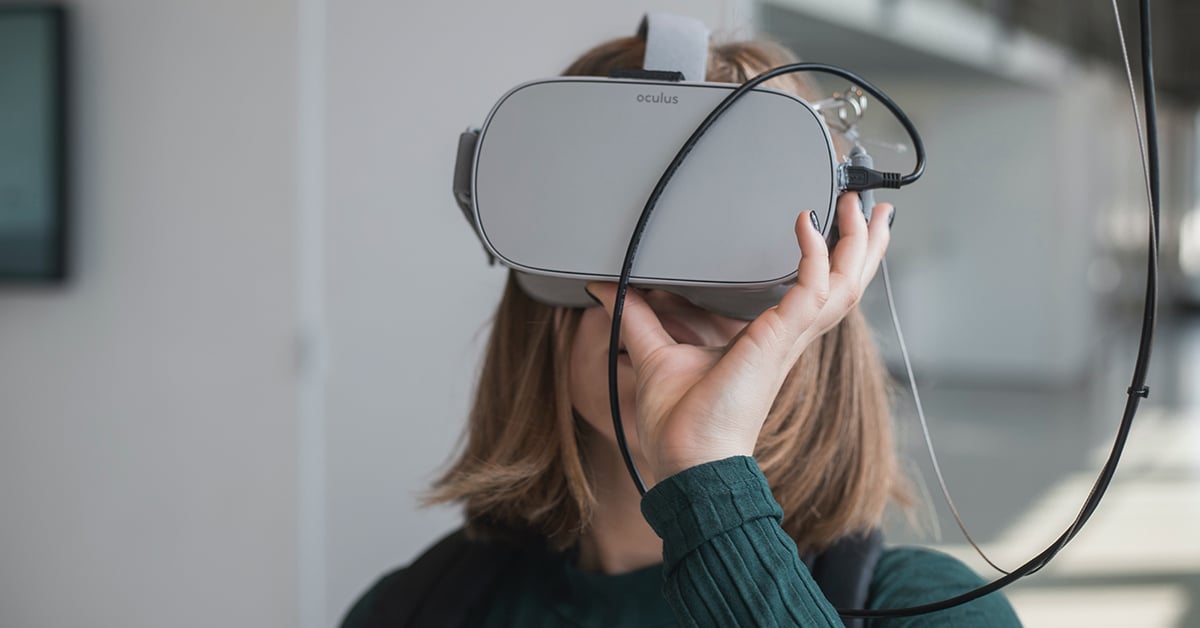
VR tourism has been a trend among the tech-savvy for some time now. But what was once a niche interest has become a new standard among various companies. Travel agencies, hotel chains, and destinations have incorporated virtual reality into their services. As you’ll soon see, the result is a breathtaking worldview.
Quick Menu:
What is virtual reality, how is the tourism industry defined, why is vr tourism gaining popularity, virtual reality gear for vr tourism, virtual booking interfaces, vr travel experiences, vr hotel tours, first airlines, visit wales, from vr tourism to tourism in the metaverse, vr tourism as a metaverse trend.
Defining and examining virtual reality before looking at VR tourism is essential. Virtual reality might seem like a fairly self-evident subject at first glance. You put on a headset and then find yourself in a digital world. But metaverse companies have created a rich ecosystem that gives you a lot of options for virtual experiences. When you think about VR, you probably imagine its fully immersive form. You experience this when using a VR headset and appropriate accessories like gloves or treadmills.
There are also non-immersive forms of VR that are experienced through traditional interfaces like computer monitors. And semi-immersive forms give you an immersive visual experience but limit your autonomy within the digital space. You can delve into a larger examination of the nature of virtual reality and the metaverse in the article “Virtual Reality; Discover VR, Its Components, Technology, and Players” .
Now that you’ve seen the VR part of VR tourism, it’s time to look at tourism as a whole. The tourism industry can be defined as the primary and tertiary economic entities surrounding and facilitating recreational travel. That description might make you think about travel agents or hotels. But you should broaden your view of it and consider how money flows into travel destinations. The tourism industry is often a subset of many other business concerns.
For example, conferences often have ties to the tourism industry. And the same holds for paid travel options in tourist destinations, restaurants frequented by travelers, etc. But not all travel falls under the label of tourism. The length of your stay essentially defines it. If you’re sticking around for more than a year, it’s not considered tourism anymore. And the same generally holds true for international students who are studying abroad.
The combination of tourism and virtual reality has taken the world by storm. And there’s good reason for that fact. The larger metaverse meaning has always focused on experiential factors. People certainly buy equipment to access the metaverse. But the real product is the experience of being in a magical new environment. And the same is true of the travel industry. When customers book flights or hotels, it’s a means to an end.
Just as with the metaverse, travelers are really buying an experience. But until recently, people couldn’t really get a taste of those experiences beforehand. Pictures and videos helped people get some ideas about what their vacation might be like. But VR provides a far more immersive experience. For the first time, people can look around and get an idea of what it’d be like to stand on distant shores or watch another land’s sunsets.
Receive Metaverse Information & Related Topics
While VR tourism is mainly focused on an experience, that doesn’t mean you can neglect your gear. Just as traditional tourism requires you to pack for the journey, so will VR tourism. This essentially means matching virtual reality gear to your particular needs. A VR headset is a given. But you should also consider whether your headset needs augmented reality or mixed reality support. VR interface controllers are also an important consideration. You can find the most important aspects of VR gear in the article “VR Headsets; Your Complete Guide to the Top Virtual Reality Gear” .
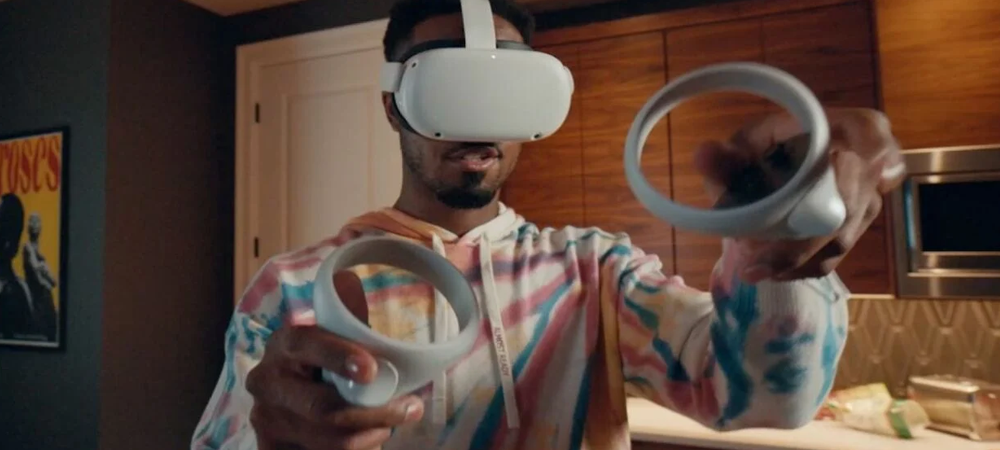
3 Examples of VR Tourism
Now that you have a good idea of the theory, it’s time to look at the practice. Technically, VR tourism can encompass almost anything. Part of what makes virtual reality so exciting is the fact that it’s only limited by imagination. But with that in mind, VR tourism techniques and technologies can largely fit into three different categories.
Virtual booking interfaces are what you experience when working on the logistics of your vacation. You can think of it as a “hub world” of sorts within the larger VR tourism experience. The virtual booking interface lets you choose hotels, consider different destinations, and even make payments. These interfaces are still in a relatively early stage of development. But if metaverse events are any indication, virtual booking interfaces will continue to grow in overall functionality. Metaverse hubs let you move from world to world. And booking interfaces will one day let you explore individual hotel facilities or compare rooms.
Video: The world’s first Virtual Reality travel search and booking experience
Most people think of VR travel experiences when they hear about VR tourism. It’s an experience that begins when people boot up VR gear from their favorite metaverse brands . From that point, they can sample some of the local flavors from around the world. It’s a chance to get a VR-based version of real-world locations. For example, you could instantly jump into a recreation of some famous landmarks to get an idea of their true size and majesty. Many companies also let you take a look at everything from hotels to their facilities before booking a trip.
Video: Ancient city of Petra, Jordan. Aerial 360 video in 8K
Hotels are often included in the larger VR travel experiences. But some hotels take VR tourism to the next level by opening up their services’ breadth. Hotels are able to take incredible high-quality photographs of their grounds since they have total control over them. This allows them to recreate areas in perfect detail essentially. The resulting model is often integrated into monoscopic views that can be used outside of virtual reality setups. For example, you can load a hotel’s monoscopic model on your phone while still having the option to use virtual reality headsets.
Video: Shangri-La Hotels Virtual Reality Tour
3 brands already investing in vr tourism.
Now that you’ve seen the tools used within VR tourism, it’s time to look at some of the best options. While many companies use VR tourism, the following are some of the most innovative and popular.
Marriott has taken on the challenge of VR tourism from two different angles. People on-site can borrow a Samsung Gear VR headset to explore the company’s Milk VR platform. Meanwhile, people can also take a look at what Marriott offers from the outside as well. This is accomplished in part through “VR Postcards” . The postcards system allows people to link their experiences to form a visual storytelling experience. Marriott’s VR isn’t just about putting yourself into an exotic environment. The platform also helps you share those experiences with loved ones back home and for posterity.
Video: VR Postcards | Behind the Scenes
First Airlines is often described as the first virtual airline. It takes VR tourism to the next level by mixing real-world and digital simulations to create a fully immersive experience. People board a perfect recreation of an A310’s cabin. The recreation even uses authentic seats from decommissioned planes. Once they board, a passenger can enjoy authentic meals based on the culinary tradition of their destination. And when that moment of arrival comes, the passenger dons a VR headset to enjoy the sights. Flight attendants are even on hand to help with meals and offer various beverage options.
Video: Japanese company First Airlines launched world’s first virtual airline
Visit Wales aims to do exactly what its name describes – help people visit Wales. Visit Wales uses VR tourism to bring the experience of visiting Wales to people worldwide. The system leverages 360° photography to capture the sights of Wales in pristine clarity. And a variety of parties have added their own resources and expertise. This allows users to sample experiences as varied as museums, countryside, castles, and courtyards. On top of the visual element Visit Wales also opens up the full scope of the region’s history through learning experiences and art collections.
Video: Zip World Velocity 360º VR Adventure – Visit Wales
VR tourism is a fantastic way to see the world. But virtual reality is itself a metaverse-related technology. Virtual reality is tied to the metaverse, so your digital travel isn’t limited to earth. You can explore an entire universe of digital sights and sounds within the metaverse. Every metaverse instance is a new world or even galaxy unto itself. Metaverse explorations provide rich experiences, fascinating people, and even opportunities to earn or win real money. You can learn more about the metaverse in the article “Metaverse Guide; Understanding The Basics Will Open Up a New World” .
VR tourism might seem like it came out of nowhere. One minute it’s just an idea, the next, there’s an entire industry built up around it. But that’s fairly common with extended reality and the metaverse in general. Metaverse companies tend to grow alongside the technologies they’re using. And make no mistake, these technologies are growing at an amazing pace. That’s why trends like NFT support in applications or metaverse games have rapidly grown. Tech development often grows exponentially. You can get a broader view of metaverse-related trends in the article “Metaverse Trends; Upcoming Milestones for the Digital Frontier” .
You might have thought of VR tourism as a futuristic concept. But as you’ve seen, you can now explore and enjoy virtual reality tourism. The call to a new adventure has begun, and you can be part of it.
Did You Like This Article About VR Tourism?
You might also be interested in the following articles:
- Roblox Metaverse; One of the Biggest Players in the Metaverse Worlds
- Decentraland Guide; Overview, Components, Things To Do & More!
- Metaverse Standards Forum; What Is it & Why Is it Needed?
More Immersive Tech-Related Tips
Related posts.

Immersive Technology Quiz; Take the Quiz to Test Your Knowledge!
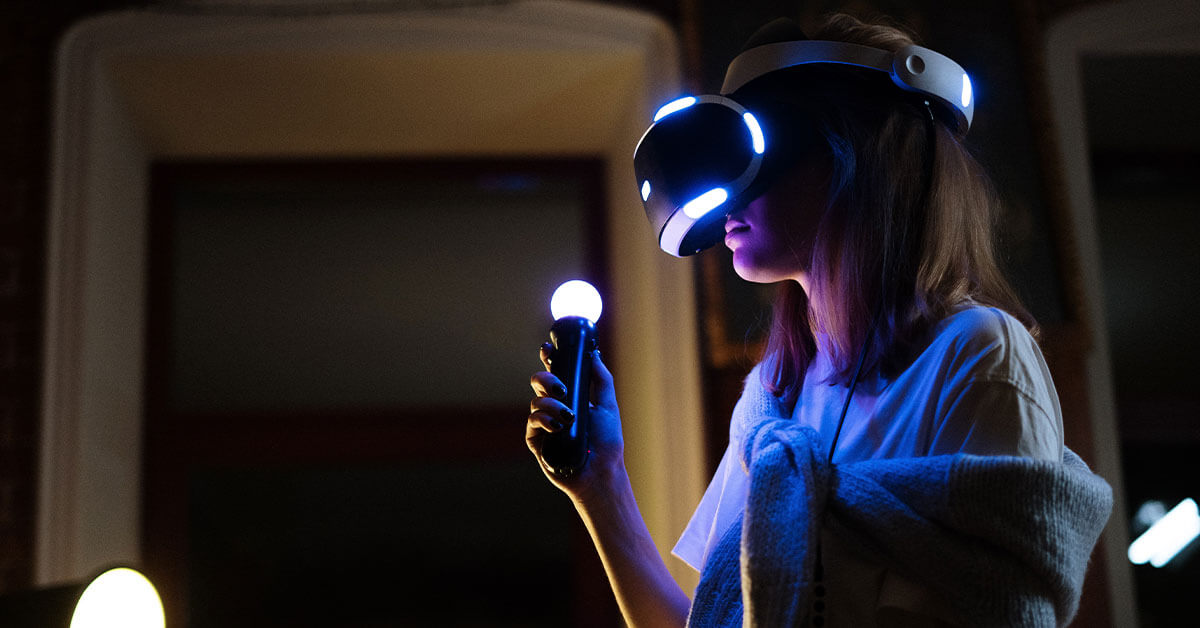
Virtual Reality Quiz; Challenge Yourself with the Ultimate VR Quiz!
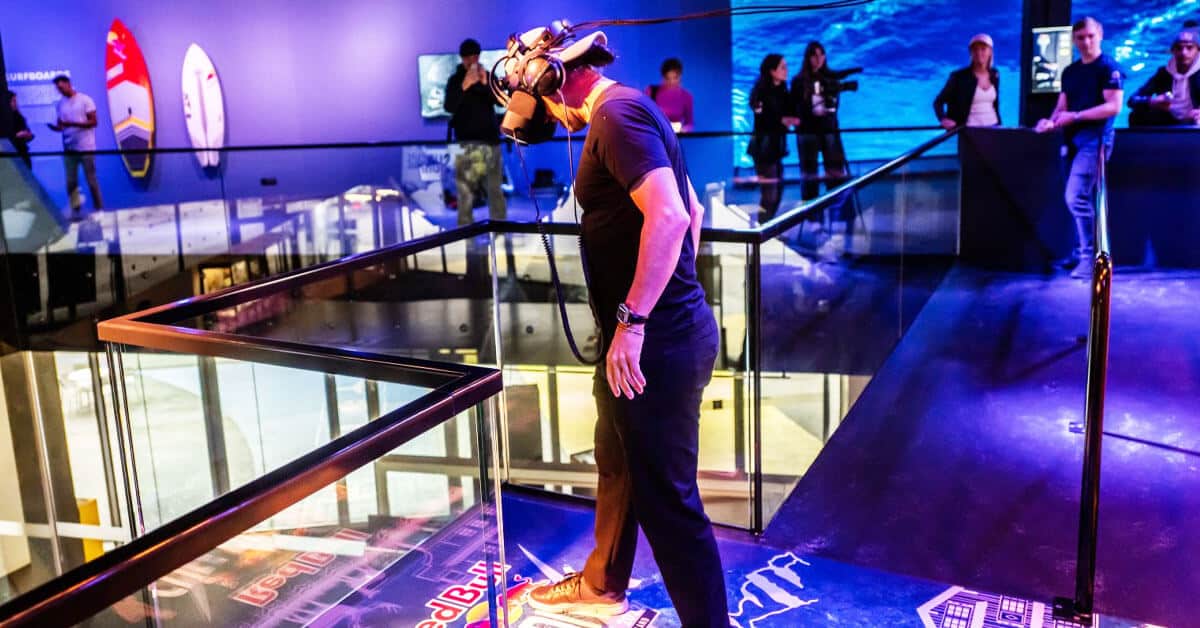
Immersive Technology; What Are Some Examples of Immersive Tech?
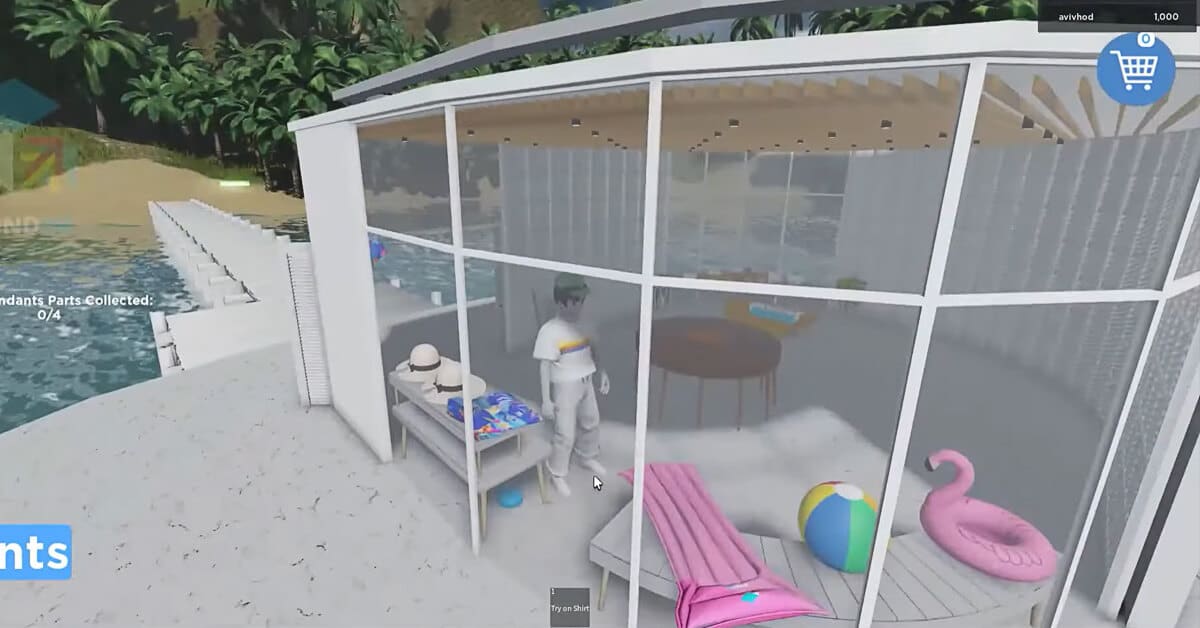
Metaverse Money; How to Make Money in the Metaverse?

Metaverse Real Estate; Learn About Investing in Virtual Real Estate
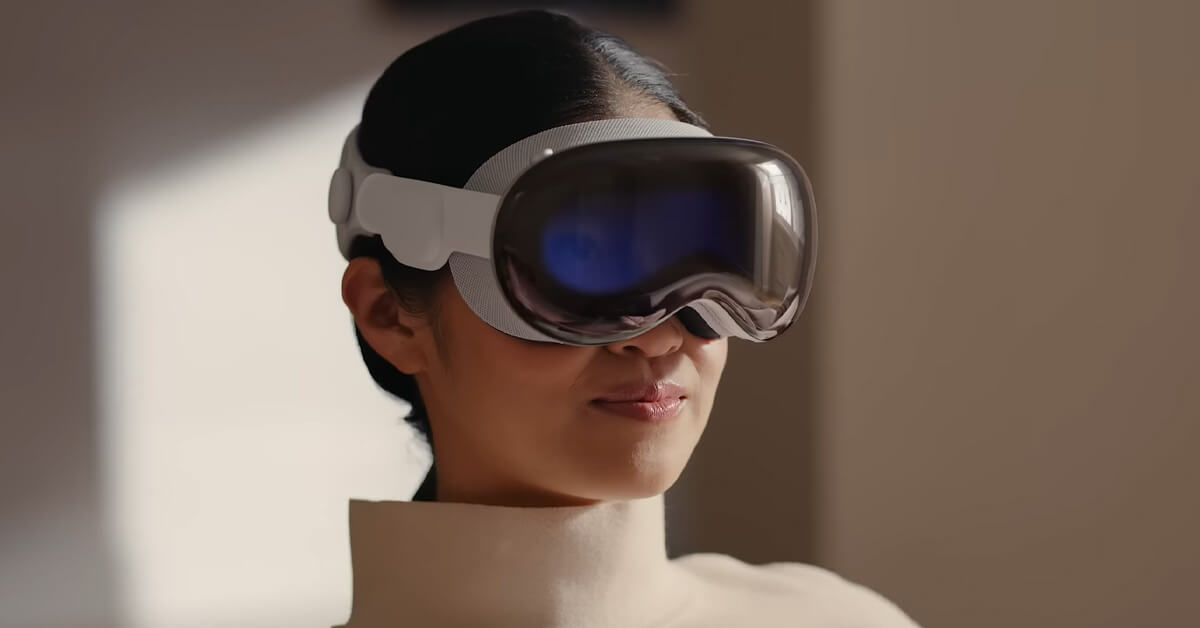
Apple Vision Pro; Everything To Know About Apple’s New MR Device!
Leave a comment cancel reply.
- Facebook Messenger
Free Metaverse Guide
Sign-up for our newsletter
and receive:
- A copy of our metaverse guide
- Practical information about the metaverse & related topics
Follow us on Social Media for the latest Metaverse Information!

- TUI Stories
- Press releases
- FY24 Q1 Results
- TUI returns to the Prime Standard
- Finance Communication
- Interviews, speeches & presentations
Virtual Reality for customers and colleagues
Interview with michele zilli who works on innovations within out it team.
Hi Michele, can you describe your role at TUI and which role VR plays in your job? I am the Head of Technology Strategy in the Advanced Engineering team of TUI Sourcing and Assets. My role means that I dedicate part of my time working on innovation in business technology – on topics like Artificial Intelligence, Advanced Data Analytics and Virtual Reality. I am also a member of the Innovation Partner Forum, organized by the TUI Group Strategy Team to identify use cases for innovation across the company.
We met you in Hanover where you organized a Virtual Reality Road Show. What are you showing in Hanover? Virtual and Augmented reality are generally known for their consumers' applications, like gaming, but most VR/AR market revenues come from business applications. In our VR Roadshow, we let people experience how they can use Virtual Reality to collaborate with colleagues using shared spaces and avatars like they were in the same room, even if they are hundreds or thousands of kilometres away from each other. The sense of closeness you can reach in virtual reality is something you need to experience in person; it's impossible to explain it with words or videos, and that's why such a roadshow is the most appropriate way of showing it. The Hanover roadshow was our first event. We will collect feedback from participants to improve the format and organise the following events and stops. We want to visit other TUI offices in the Northern, Central and Western Region, but we do not have yet the dates planned.
Where do you see a role for VR technology at TUI? Oh well, it's challenging to answer since there are many possibilities, and it also depends on the timeframe we consider. At this moment, we can use Virtual and Augmented reality (Immersive Technologies) for internal use cases like team collaboration or training; technology is good enough and at the right price point to allow for significant adoption. And we see every month news about companies adopting VR for these purposes. Also, in the consumers space, we may see early adoption of AR use cases using phones and tablets, like helping customers with indoor and outdoor navigation at the destination. As technology evolves in the following years, and the form factor and price point of VR/AR glasses will improve, we will see more complex VR and AR customers use cases emerging. Imagine visiting a resort or a destination before travelling, having fun in a VR escape room on a cruise ship or experiencing a museum tour with your friends during your lunch break.
How do you make sure that the things you are working on are closely connected to business needs? In general, we answer business questions or solve business problems in close collaboration with our commercial and markets counterparts. The problem is that, sometimes, we are so deeply involved in our day to day activities that we may miss opportunities that are just outside our field of view. Working on innovation topics and with Start-up Incubators allows us to tap into a stream of creative solutions. Our job then is to map these solutions to our colleagues' expressed requirements, and it's a top-down approach.
And that is what you did with VR? During the pandemic, we shifted from work at the office to the home office, and this change will persist, and most of us like it. At the same time, we miss our colleagues, meeting in person, brainstorming using a whiteboard and sticky notes. This need is profoundly human, but often it is not expressed as a business requirement. So a bottom-up approach is required; we start from a potential solution, and then we collect as much data as possible with our colleagues to understand if there is real value in it and the positive and negative outcomes of it.
VR is a rather new technology. How do you make sure to be at the forefront of developments? Virtual Reality was born in the '60s, so it is not inherently new. What happened is that now we are experiencing the convergence of technologies that enables the construction of consumer-grade VR appliances at a reasonable price point with a good enough form factor. It is becoming hard at times because the Immersive Technologies market is booming, and new things are happening every week, but we are passionate technologists, and this vitality makes our job interesting. As for other topics, we closely follow the market, the published research and our peers in the industry.
We use cookies to provide you with an optimized website experience. They include cookies for the operation and optimization of the website as well as cookies for analyses, retargeting and to provide personalised content on websites by third party providers. By clicking on Accept you are agreeing to the use of non-essential cookies. If you don't want that, you can Decline All the use of cookies or change your Settings at any time. For more information, including the processing of data by third party providers, see our Cookie Notice . You can find further information on the use of cookies at any time in our Cookie Notice and our Privacy policy . You will find the Imprint here.
Choose which cookies are permitted by using the “Status”-Switch. Save your settings with the button “I Agree”.
You can find further information on the use of cookies at any time in our Cookie Notice and our Privacy policy . You will find the Imprint here.
Virtual reality and modern tourism
Journal of Tourism Futures
ISSN : 2055-5911
Article publication date: 29 April 2020
Issue publication date: 2 June 2021
The purpose of this paper is to provide an insight as to how recent trends in virtual reality (VR) have changed the way tourism and hospitality industry communicates their offerings and meets the tourists’ needs.
Design/methodology/approach
The approach is based on systematic literature review, where the relations between focal concepts are given to analyze potential future developments concerning VR.
The paper identifies and analyzes how VR technology affected tourism and hospitality industry through three main touch points – future tourism planning and management, technology-based marketing of tourism destinations and VR potential in changing consumer requirements. These concepts were analyzed to identify changing forces and suggest potential paradigm shifts that tourism and hospitality suppliers and marketers need to consider. These included realistic virtual travel replacements, the importance of interactive experiences and innovation in future tourism systems.
Originality/value
While there has been increasingly larger number of discussions on how tourists and tourism and hospitality industry have been using information and communication technology recently, there is little evidence of scholars and practitioners applying such methods. This paper used systematic literature review to illustrate means in which VR could be ingrained into tourism and hospitality services to meet the needs of tourists. It suggests that VR can and probably will fundamentally change the way in which tourists’ experiences and requirements are managed entirely.
- Virtual reality
- Development
- Emerging trends
Pestek, A. and Sarvan, M. (2021), "Virtual reality and modern tourism", Journal of Tourism Futures , Vol. 7 No. 2, pp. 245-250. https://doi.org/10.1108/JTF-01-2020-0004
Emerald Publishing Limited
Copyright © 2020, Almir Pestek and Maida Sarvan.
Published in Journal of Tourism Futures . Published by Emerald Publishing Limited. This article is published under the Creative Commons Attribution (CC BY 4.0) license. Anyone may reproduce, distribute, translate and create derivative works of this article (for both commercial and non-commercial purposes), subject to full attribution to the original publication and authors. The full terms of this license may be seen at http://creativecommons.org/licences/by/4.0/legalcode
Introduction
One of the most significant developments in the field of information and communication technology (ICT) expected to greatly impact the tourism industry today is virtual reality (VR). Many of the recent innovations such as VR platforms, devices and content production tools enable the evolution of VR. As such, VR technologies nowadays offer unbounded potentials for mass virtual visitations to actual tourism destinations. Moreover, the roles of such technologies in tourism and hospitality industries, its management and marketing have been described in literature as capable of showing their intricate abilities to simulate real-life situations and contexts, occasionally being touted as a substitute to actual travel, making it a very powerful tool for meeting the needs of tourists.
The changes that are supposed to occur in the next few years are always underestimated and come even sooner. Tourism and hospitality organizations should be urged to be more future-oriented and prepared fully for the planning of technology adaptations. The paper aims at establishing relations between concepts of VR and tourism and hospitality industry and presenting opportunities for the tourism sector taking in consideration the values expressed in the concept of VR marketing in efforts of meeting the needs of tourists in the future. The paper explores the potential of valuable tool such as VR with regard to tourism planning and management, technology-based marketing of tourism destinations and effects of VR on consumer requirements.
The paper is based on the literature review. The following digital bases were used in the process of research: Emerald Database, IOPscience, SCOPUS, EBSCO, ABI/INFORM Complete – ProQuest. The items in the search string were connected with OR statements, to make sure that all relevant papers were retrieved - “virtual reality,” “virtual reality marketing,” “virtual reality experience,” “augmented reality experience,” and “ICT in tourism”. Only 49 articles were yielded because of their relevance after applying the exclusion/inclusion criteria. Inclusion criteria include: published articles between 2010 and 2019; articles written in English, scientific and peer-reviewed articles; studies published in electronic digital libraries from newspapers or journals; and educational conferences. Exclusion criteria are as follows: duplicated papers and studies returned by different search engines, papers and works that focus on low-level comparison, editorials and non-reviewed articles. Based on these studies the conclusions are drawn throughout the paper.
Technology-based marketing of tourism destinations
VR is often defined as the technology using the computer-generated 3D environment often referred to as “virtual environment.” The real-time simulation of one or more of the five senses of the user is often a result of navigation through this virtual environment and interaction with it ( Gutierrez et al. , 2008 ). Physical immersion and psychological presence are provided in VR experience as well.
The marketing and promotion segments of the tourism sector have most often been used with the assistance of visual imagery ( Aziz and Zainol, 2011 ). The intangible properties of tourism, as a service, constantly reminds the marketers that there is a need to continuously innovate the forms of visual imagery with the objective to promote a positive destination image ( Griffin et al. , 2017 ). As a useful tool used by marketers in establishing the communication of emotions and experiences influencing the consumers and tourists, VR is often used because of its ability to induce the emphasized sensory and emotional experience.
The opportunities of VR in regard to destination marketing organizations are found in the way in which marketing messages are targeted to specific markets, whilst capturing the attention of potential visitors and giving assistance in relevant factors identification that essentially create motivations for those that engage in any form of VR and awareness development in reference to future travel decision-making processes ( Huang et al. , 2013 ). Research indicates that virtual tourists can have their travelling needs easily fulfilled under the following conditions: taking into consideration the hedonistic and emotional experiences, virtual tourism destinations can give visitors the chance to enhance their perceptions and virtual world is displayed as a source of useful information.
To conclude, VR in marketing of tourism destinations can be associated with attachment ( Wu et al. , 2016 ), stimulation ( Neuburger et al. , 2018 ), evaluation (Gao et al. , 2012), decision-making ( Guo and Barnes, 2011 ) and experience ( Jung et al. , 2017 ).
Virtual reality changes tourism planning, management and consumer requirements
VR is considered a very valuable tool in tourism policy creation as well as in the planning processes ( Cheong, 1995 ). The tourism planner’s consideration of possible developments in the sector is often aided by VR’s ability to create realistic and navigable virtual environments.
The tourism planning and management can be benefited by VR technology, as it possesses the unique testing capabilities ( Sussmann and Vanhegan, 2000 ). The understanding of visitors’ patterns of space, time and place is a very important element in developing management plans, which include shifting the burden from areas with heavy use to those with limited use. 3D visualizations are excellent tools in doing so ( Lew and McKercher, 2005 ). Furthermore, as VR technology continues to evolve, the entertainment industry has found a way to make these evolutions very useful in regards to marketing the entertaining tourist attractions ( Gutierrez et al. , 2008 ).
A set of concepts which are interrelated identify the current trends in tourism and its references to marketing, consumer behavior and tourist needs and the ways in which these affect the end users’ attachment, stimulation and decision-making process ( Epple, 2018 ). Research that explores the consumer behavior in VR tourism through the example of using the stimulus – organism – response model identifies that the brands and tourism organizations are able to affect the users’ opinions and decisions directly and effectively through this interactivity, experience and immersion ( Kim et al. , 2018 ).
The roles of hedonic experience and emotional arousal are found to be large in regards to determining the potential tourists’ behavioral intentions to visit a given destination and also in motivating them to become the potential tourists ( Jung et al. , 2017 ). On a similar note, the navigation of 3D environment is found to induce positive emotions, flow and emotional involvement, which results in positive effects on behavioral intentions, further extending the engagement and immersive experience that enhances the tourist’ needs.
As a subsequent consequence of advancement in virtual technologies, the impression of investors and consumers continues to grow and VR is being envisioned and implemented largely to meet the future needs of tourists. The potential of VR technologies in meeting the future tourists’ needs is large and the research identifies the major trends in tourism sector in regards to this in the further text ( Nayyar et al. , 2018 ).
Identified trends in tourism industry are found in effective planning and suitable management. As the almost-realistic, easy and detailed navigations created through the VR are readily available for tourists to help in their trip- and activity-planning processes, its potential is further widened. Furthermore, the trend is identified through creation of various types of simulators which allow for the virtual experience, where potential tourists are able to experience a destination in advance, such as in the case of some destination marketing organizations ( Tussyadiah et al. , 2018 ).
The VR technologies are already used in provision of tourists with experience previews of sites, destinations and attractions, such as hotels, cruise ships and similar, as a part of the marketing strategy ( Samuely, 2016 ). Virtual conative image that most often results in potential purchase intention is yielded through Web-mediated virtual information ( Hyun and O’Keefe, 2012 ).
The applications of VR are largely found in the initial phases of customer buying cycle in the area of tourism, because it enables the extensive information about important factors that play a significant part in the search stage of the process of decision-making ( Kim et al. , 2018 ). Furthermore, the perfect digital environment enables for the creation of virtual attractions at an effective cost, which are identified in simulators and marketable tourist attractions. Examples of these include the “Sensorama Simulator” that, through the 3D images, aromas, sounds, wind, set vibrations and similar, offers entertaining, simulated motorcycle rides through New York City ( Gutierrez et al. , 2008 ). Also, an example of such application of VR in entertainment industry is found in theme parks, such as the Dreamworld theme park, with simulated car rides ( Dreamworld, 2009 ) and also Cyber Speedway in the city of Las Vegas ( Sahara Hotel and Casino, 2009 ).
A large trend in the sector is identified in provisions of virtual tours as well, including the handling of virtual objects, interactive and immersive experience and a realistic picture of the site. This is most commonly used in heritage areas, hotels and museums, including the zoo exhibits ( Bowman et al. , 1999 ), VR exhibits in cultural centers globally ( Roussou, 2004 ), viewing of heritage sites ( Thomasson, 2006 ), production of interactive tours ( Tholos, 2009 ), selection of tourist attractions within an area ( Linaza et al. , 2008 ) and so on.
Many hotels have demonstrated that the VR trend is very useful in the destination marketing area as well and as such the room booking process has been entirely transformed ( Neuburger et al. , 2018 ). Technology provides for prospective guests to virtually visit rooms and consider their offers, like in the case of Marriott Hotels, including the previews of the local attractions, giving potential tourists insights in destinations.
Another example of VR trend is identified by Telexistence, a company that has been working with a real-life avatar, where the user is enabled to see what the avatar sees and to also receive haptic feedback (Telexistence Inc., 2020). Such example is very important in identification of possibilities in meeting the tourists’ needs in the future, such as a travel decision that will immediately satisfy their need after a particular interest and desire is awaken, whilst also enabling for VR travel to be possible, allowing the tourists which might possibly be intimidated by certain destinations and as such, would only visit them virtually, as in the case of possible existence of potential geographical barriers, fears, dangerous locations and similar.
The identified trends indicate that VR technology will most likely become an invaluable tool in the next few years ( Barnes, 2016 ), which consequently will dictate the marketers to custom make the VR experiences for the varying users and offer the best possible VR services to meet the consumers’ future needs most optimally.
Certain conclusions can be drawn implying that the VR is changing tourism planning and consumer requirements can be associated with 3D visualizations ( Brent Ritchie et al. , 2011 ), simulators ( Tom Dieck et al. , 2016 ), virtual tours ( Tung and Law, 2017 ), previews ( Epple, 2018 ) and effective planning ( Kask, 2019 ).
Conclusions
VR is being developed as a part of smart tourism to provide information about destinations and attractions while showing its potential to become a new tourism service. Nonetheless, the trend has proven to be very useful, however slow, because of the difficulties of tourists to keep up with new technologies. Thanks to VR, tourists are able to experience a destination in advance and to preview local attractions. Interactive, realistic, easy and detailed VR navigations help tourists in the trip-planning processes and activity planning.
VR technologies will surely continue to advance, and as such, the opportunities in the tourism sector will grow exponentially. Regardless of the direction in which these advancements and developments take place, immediate applications and trends are identified and used within the tourism industry already.
Whilst many limitations do exist, the future will show the technologies to be much better understood. VR can and probably will fundamentally change the way in which tourists’ experiences and requirements are managed entirely.
Aziz , A. and Zainol , N.A. ( 2011 ), “ Destination image: an overview and summary of selected research (1974-2008) ”, International Journal of Leisure and Tourism Marketing , Vol. 2 No. 1 , pp. 39 - 55 .
Barnes , S. ( 2016 ), “ Understanding virtual reality in marketing: nature, implications and potential ”, SSRN Electronic Journal .
Bowman , D.A. , Hodges , L.F. , Allison , D. and Wineman , J. ( 1999 ), “ The educational value of an information-rich virtual environment ”, Presence: Teleoperators and Virtual Environments , Vol. 8 No. 3 , pp. 317 - 331 .
Brent Ritchie , J.R. , Wing Sun Tung , V. and Ritchie , R. ( 2011 ), “ Tourism experience management research: emergence, evolution and future directions ”, International Journal of Contemporary Hospitality Management , Vol. 23 No. 4 , pp. 419 - 438 .
Cheong , R. ( 1995 ), “ The virtual threat to travel and tourism ”, Tourism Management , Vol. 16 No. 6 , pp. 417 - 422 .
Dreamworld ( 2009 ), “ Dreamworld – attractions – V8 supercars RedLine ”, available at: www.dreamworld.com.au/content/drw_2008_standard.asp?name¼V8supercars_RedLineMain (accessed 9 January 2020 ).
Epple , C.H. ( 2018 ), “ Virtual reality tools in the tourism industry and their influence on booking behavior ”, PhD thesis, Technische Universität München .
Griffin , T. , Giberson , J. , Lee , S.H. , Guttentag , D. , Kandaurova , M. , Sergueeva , K. and Dimanche , F. ( 2017 ), “ Virtual reality and implications for destination marketing ”, Travel and Tourism Research Association: Advancing Tourism Research Globally , Vol. 29 .
Guo , Y. and Barnes , S. ( 2011 ), “ Purchase behavior in virtual worlds: an empirical investigation in second life ”, Information & Management , Vol. 48 No. 7 , pp. 303 - 312 .
Gutierrez , M. , Vexo , F. and Thalmann , D. ( 2008 ), Stepping into Virtual Reality , Springer , London .
Huang , Y.C. , Backman , S.J. , Backman , K.F. and Moore , D. ( 2013 ), “ Exploring user acceptance of 3D virtual worlds in travel and tourism marketing ”, Tourism Management , Vol. 36 , pp. 490 - 501 .
Hyun , M.Y. and O’Keefe , R.M. ( 2012 ), “ Virtual destination image: testing a telepresence model ”, Journal of Business Research , Vol. 65 No. 1 , pp. 29 - 35 .
Jung , T. , Tom Dieck , M.C. , Moorhouse , N. and Tom Dieck , D. ( 2017 ), “ Tourists’ experience of virtual reality applications ”, IEEE conference on Consumer Electronics , Las Vegas .
Kask , S. ( 2019 ), “ Virtual reality in support of sustainable tourism. Experiences from Eastern Europe ”, Dspace.emu.ee , available at: http://dspace.emu.ee/xmlui/handle/10492/4549 (accessed 24 January 2019 ).
Kim , M. , Lee , C. and Jung , T. ( 2018 ), “ Exploring consumer behavior in virtual reality tourism using an extended stimulus-organism-Response model ”, Journal of Travel Research , Vol. 59 No. 1 , pp. 69 - 89 .
Lew , A. and McKercher , B. ( 2005 ), “ Modeling tourist movements: a local destination analysis ”, Annals of Tourism Research , Vol. 33 No. 2 , pp. 403 - 423 .
Linaza , M.T. , Garcia , A. , Torre , I. and Torres , J.I. ( 2008 ), “ Interacting with augmented assets in cultural tourism ”, in Pan , Z. , Zhang , X. , Rhalibi , A.E. , Woo , W. and Li , Y. (Eds), Proceedings of Edutainment, 3rd Annual Conference Nanjing, Springer – Verlag , pp. 107 - 117 .
Nayyar , A. , Mahapatra , B. , Nhuong Le , D. and Suseendran , G. ( 2018 ), “ Virtual reality (VR) & augmented reality (AR) technologies for tourism and hospitality industry ”, International Journal of Engineering & Technology , Vol. 7 No. 2.21 , p. 156 .
Neuburger , L. , Beck , J. and Egger , R. ( 2018 ), “ The ‘phygital’ tourist experience: the use of augmented and virtual reality in destination marketing ”, in Camillieri , M. (Ed.), Tourism Planning and Destination Marketing , Emerald Publishing Limited , pp.183-202
Roussou , M. ( 2004 ), “ Learning by doing and learning through play: an exploration of interactivity in virtual environments for children ”, Computers in Entertainment , Vol. 2 No. 1 , pp. 1 - 23 .
Sahara Hotel & Casino ( 2009 ), “ Las Vegas NASCAR cyber speedway at the Sahara hotel & casino ”, available at: www.saharavegas.com/NASCAR/cyber-speedway (accessed 9 January 2020 ).
Samuely , A. ( 2016 ), “ Hilton checks in virtual reality push via 360-degree video experience ”, available at: www.mobilemarketer.com/cms/news/video/22759.html (accessed 30 April 2019 ).
Sussmann , S. and Vanhegan , H. ( 2000 ), “ Virtual reality and the tourism product: substitution or complement? ”, Proceedings of the European conference on information systems .
Telexistence Inc. ( 2020 ), “ TELEXISTENCE inc ”, available at: https://tx-inc.com/en/home/ (accessed 9 January 2020 ).
Tholos ( 2009 ), “ Tholos virtual theater ”, available at: http://tholos254.gr/en/index.html (accessed 9 January 2020 ).
Thomasson , R. ( 2006 ), “ Get in touch with the past ”, Wired , Vol. 14 No. 5 , available at: www.wired.com/wired/archive/14.05/start.html?pg¼8 (accessed 9 January 2020 ).
Tom Dieck , M.C. , Jung , T.H. and Tom Dieck , D. ( 2016 ), “ Enhancing art gallery visitors’ learning experience using wearable augmented reality: generic learning outcomes perspective ”, Current Issues in Tourism , Vol. 21 No. 17 , pp. 1 - 21 .
Tung , V.W.S. and Law , R. ( 2017 ), “ The potential for tourism and hospitality experience research in human-robot interactions ”, International Journal of Contemporary Hospitality Management , Vol. 29 No. 10 , pp. 2498 - 2513 .
Tussyadiah , I.P. , Wang , D. , Jung , T.H. and Tom Dieck , M.C. ( 2018 ), “ Virtual reality, presence, and attitude change: empirical evidence from tourism ”, Tourism Management , Vol. 66 , pp. 140 - 154 .
Wu , D. , Weng , D. and Xue , S. ( 2016 ), “ Virtual reality system as an affective medium to induce specific emotion: a validation study ”, Electronic Imaging , Vol. 2016 No. 4 , pp. 1 - 6 .
Further reading
Gao , L. , Bai , X. and Park , A. ( 2017 ), “ Understanding sustained participation in virtual travel communities from the perspectives of is success model and flow theory ”, Journal of Hospitality and Tourism Research , Vol. 41 No. 4 , pp. 475 - 509 .
Corresponding author
About the authors.
Almir Pestek is based at the School of Economics and Business, University of Sarajevo, Sarajevo, Bosnia And Herzegovina.
Maida Sarvan is based at NLB Bank d.d. Sarajevo, Sarajevo, Bosnia And Herzegovina.
Related articles
We’re listening — tell us what you think, something didn’t work….
Report bugs here
All feedback is valuable
Please share your general feedback
Join us on our journey
Platform update page.
Visit emeraldpublishing.com/platformupdate to discover the latest news and updates
Questions & More Information
Answers to the most commonly asked questions here
Blog , Virtual Reality
VR In Tourism: Benefits And Use Cases
- By Gaurav Patil
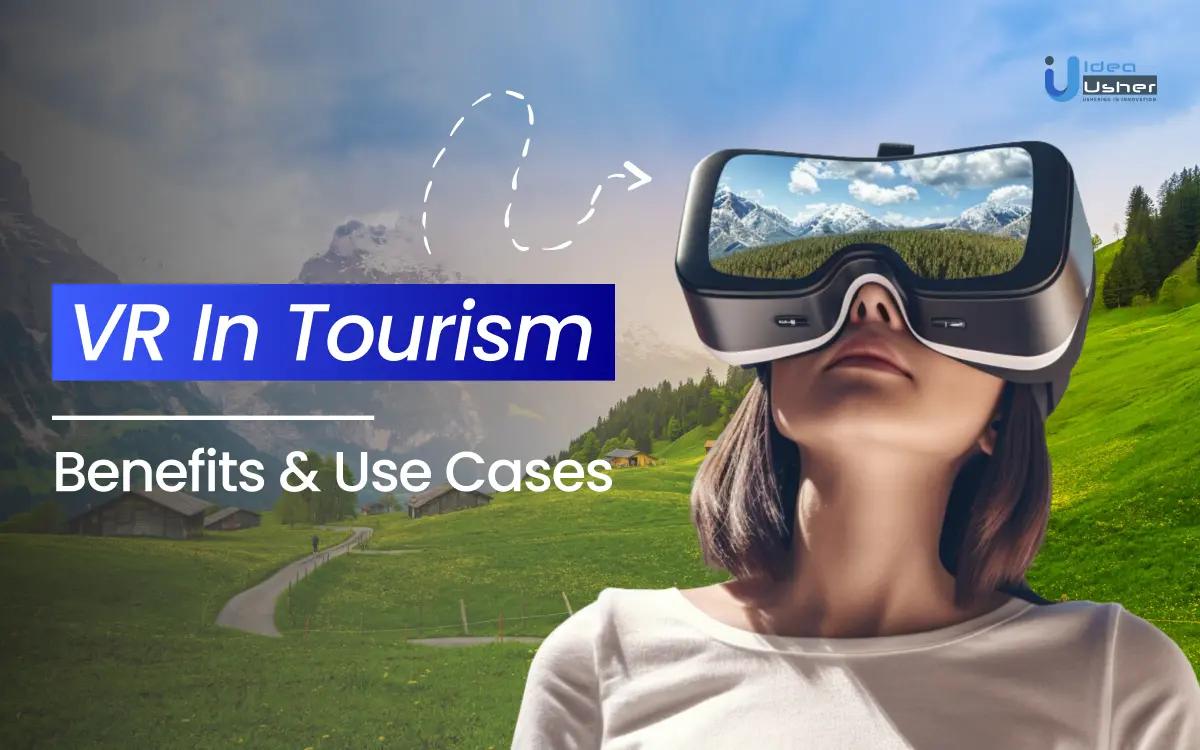
Virtual reality in tourism provides viewers with an immersive tourism experience. There are many different types of virtual tourism services available. They use a combination of virtual reality, still images, video, audio, narration, and other multimedia formats.
Virtual tourism content can be accessed using a virtual reality headset for the most immersive experience. It can also be viewed on a regular computer or even a mobile device.
By using the power of VR technology, businesses can create immersive and accessible experiences that inspire curiosity, foster cultural understanding, and drive economic growth within the global tourism landscape.
In this article, we’ll explore into the world of VR applications in tourism, covering essential aspects such as key features, development processes, and cost estimation factors to understand how to effectively integrate VR into the tourism sector.
Market Stats For VR In Tourism
What is virtual reality in travel, benefits of virtual reality in tourism, vr trends for the virtual travel industry, use cases of virtual reality in tourism, examples of virtual reality in tourism, how to develop a vr app for travel industry, cost affecting factors to consider to develop a vr based travel app, tech stack to consider to develop a vr based travel app, how can we help in developing a vr based virtual travel app.
Virtual Reality (VR) technology is transforming the tourist business, providing immersive experiences that transport consumers to destinations across the world from the comfort of their own homes.
With advances in VR hardware and software, tourism businesses are using this technology to increase customer interaction and promote interest in tourist destinations like never before.
As per a report from Statista, the market size for global virtual tourism is expected to reach 24 billion U.S. dollars by 2027 .
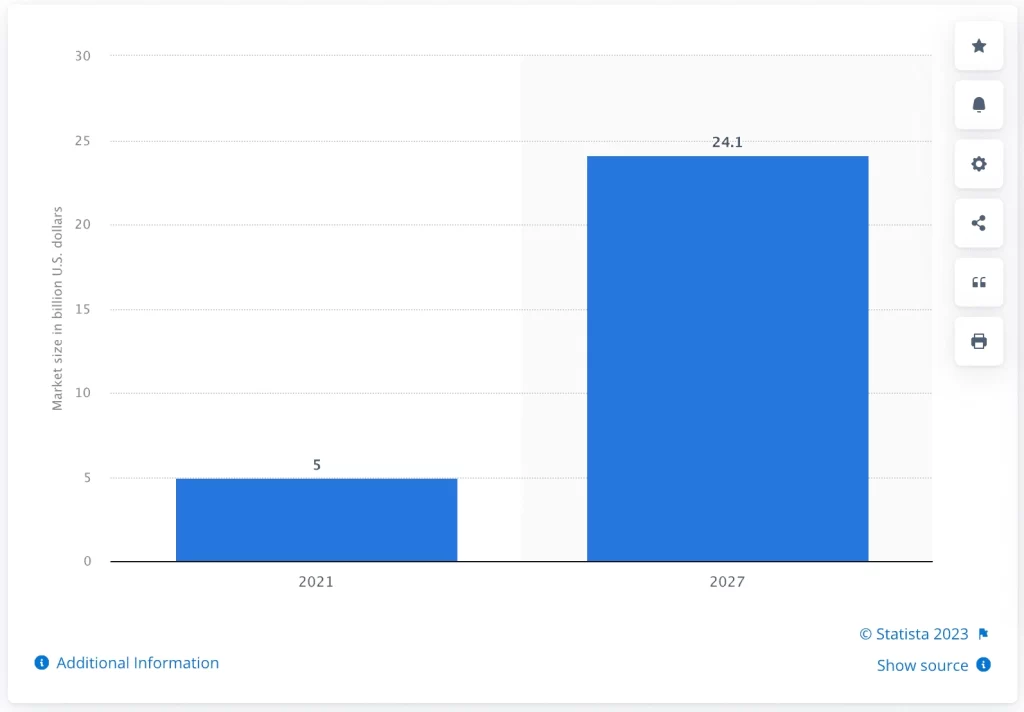
Source: Statista
The expanding global tourism market presents a lucrative opportunity for VR development in tourism.
As more travellers seek immersive experiences, VR offers a compelling solution to showcase destinations remotely. Capitalizing on this trend can lead to increased demand for VR content, driving growth and profitability in the tourism industry.
Virtual reality (VR) in travel entails the creation of interactive images or videos that allow viewers to explore a scene in full 360 degrees. Unlike traditional media captured from fixed viewpoints, VR technology captures every aspect of a location, providing a more immersive experience.
In the travel industry, VR is used to showcase tourism destinations in a unique and engaging manner. Specialized cameras, rigs, and software are employed to capture the content, which can then be experienced through VR headsets or on standard devices such as computers or mobile phones.
While some may believe that VR content is exclusive to dedicated VR headsets, it can actually be accessed on any device, offering varying levels of immersion. For instance, at Immersion VR, we produce tourism VR content that can be explored by clicking or swiping across the video to view the entire 360-degree environment.
Virtual reality (VR) has revolutionized the tourism industry by offering immersive experiences that transcend physical limitations. From virtual tours of destinations to interactive cultural explorations, VR enhances travel planning and fosters global connectivity.
1. Immersive Destination Experience
Virtual reality (VR) offers a unique and immersive way for users to experience travel destinations without physically being there. By transporting users to different locations, VR allows them to vividly imagine themselves at a travel destination, fostering a sense of connection and anticipation.
2. Detailed Destination Showcase
One of the key advantages of VR in tourism is its ability to showcase destinations in stunning detail. Through high-resolution, 360-degree views, users can explore every angle of a destination, providing them with a comprehensive understanding of what it has to offer.
3. Flexible Exploration
Moreover, VR empowers users to navigate and explore scenes at their own pace and according to their preferences. This flexibility enhances the user experience, allowing individuals to tailor their virtual journey to their interests and desires.
4. Memorable Interactions
In addition to offering immersive experiences, VR in tourism creates memorable and unique interactions for users. By simulating real-world environments and activities, VR can evoke strong emotions and leave a lasting impression on users, making their virtual travel experiences truly unforgettable.
5. Innovative Brand Engagement
From a marketing perspective, VR enables travel companies to differentiate themselves and engage with consumers in innovative ways. By leveraging VR technology, companies can create distinctive brand experiences that capture the attention of potential travelers and set themselves apart from competitors.
6. Accessibility Enhancement
Furthermore, VR has the potential to make travel accessible to individuals who may face limitations or barriers to traditional forms of tourism. Whether due to physical disabilities, financial constraints, or other reasons, VR can provide these individuals with the opportunity to explore destinations and cultures from the comfort of their own surroundings.
7. Sustainability Contribution
Importantly, VR in tourism can also contribute to sustainable travel practices by reducing the environmental impact of traditional tourism activities. By offering virtual alternatives to physical travel, VR can help minimize overcrowding and mitigate the negative effects of tourism on vulnerable destinations and ecosystems.
Virtual reality (VR) travel trends have surged in popularity, with travel companies actively offering immersive VR experiences to their customers. These experiences often include simulated journeys to various destinations, allowing users to explore different places from the comfort of their own homes.
1. VR Travel Experiences by Travel Companies
2. virtual hotel tours by travel companies and hotels.
Both travel companies and hotels are increasingly providing virtual tours of their accommodations, giving potential guests a detailed preview of their facilities and amenities before making a booking decision.
3. Technologies to Make VR Travel More Realistic
To enhance the realism of VR travel, ongoing advancements in technology are being implemented. These innovations aim to replicate the sights, sounds, and even sensations of being in a particular location, thus providing users with a more authentic and immersive experience.
4. VR Travel Experiences for the Elderly
Recognizing the potential of VR technology to cater to diverse demographics, there is a growing focus on creating VR travel experiences specifically tailored to the elderly population. These experiences are designed to cater to the unique needs and preferences of older individuals, offering them opportunities to virtually explore destinations they may not have been able to visit physically.
5. VR Flight Experiences
VR flight experiences have gained traction as a novel way for users to virtually experience air travel. These simulations allow users to immerse themselves in the entire flight process, from boarding to landing, providing a realistic portrayal of the flying experience without leaving the ground.
6. Virtual Experiences of Landmark Destinations
Another popular trend in VR travel is the creation of virtual experiences of landmark destinations. Users can virtually visit iconic landmarks and tourist attractions worldwide, gaining insights into their history, significance, and architectural marvels through immersive VR environments.
7. Virtual Booking Interface
Moreover, the development of virtual booking interfaces simplifies the process of planning and booking travel experiences within the VR environment. These interfaces enable users to browse destinations, view accommodations, and make bookings seamlessly, all within the immersive VR environment, enhancing the overall convenience and accessibility of VR travel.
Virtual reality (VR) is revolutionizing tourism by offering immersive experiences that allow travelers to explore destinations, engage in cultural activities, and preview accommodations, enhancing trip planning and the overall tourist experience. Here are some of the use cases
1. Virtual Destination Exploration
Through virtual reality (VR), prospective tourists can engage in comprehensive exploration of various destinations. This technology offers detailed virtual tours of landmarks, museums, or natural wonders, presenting a 360-degree immersive experience. By virtually visiting these locations, travelers can gather information, assess the appeal of destinations, and plan their trips more effectively.
2. Virtual Travel Experiences
VR technology transports users into diverse travel experiences, from iconic activities like riding a gondola in Venice to adventurous endeavors like hiking through a rainforest or even encountering wildlife like swimming with dolphins. These simulated adventures provide travelers with a taste of different cultures and environments, sparking their interest in exploring new destinations and embarking on unique experiences.
3. Virtual Hotel and Accommodation Tours
Hotels and resorts leverage VR to offer detailed virtual tours of their accommodations. Prospective guests can virtually explore various room types, amenities, and facilities, gaining a realistic sense of the lodging options available. This immersive experience empowers travelers to make well-informed decisions about their accommodations, leading to increased bookings for hospitality businesses.
4. Virtual Historical Reconstructions
VR technology enables the recreation of historical sites and events, providing tourists with immersive experiences of significant moments in history. By virtually stepping into the past, visitors can gain a deeper understanding of historical contexts, civilizations, and cultures. These immersive reconstructions enrich educational tourism, offering insights into diverse historical periods and fostering cultural appreciation.
5. Virtual Cultural Immersion
Cultural institutions and tourism organizations utilize VR to offer immersive cultural experiences to audiences worldwide. Through virtual platforms, users can participate in virtual festivals, ceremonies, or cultural performances, immersing themselves in the traditions and customs of different societies. This virtual cultural immersion fosters cross-cultural understanding and appreciation, promoting cultural exchange and dialogue.
6. Virtual Reality Travel Agencies
Modern travel agencies integrate VR technology into their services, offering virtual consultations and immersive presentations to clients. Through VR platforms, travelers can preview destinations, activities, and accommodations in a highly immersive manner. These virtual experiences enhance the booking process, enabling travelers to make informed decisions and tailor their travel experiences according to their preferences.
7. Virtual Tour Guide Services
VR-based tour guide services provide personalized, immersive tours led by virtual guides. Travelers can interact with these virtual guides, who offer informative commentary, historical facts, and navigation assistance throughout the virtual tour. This interactive experience enhances the overall tourist experience, providing travelers with insightful guidance and enriching their exploration of destinations.
Discover the world from the comfort of your home with virtual reality tourism. Explore stunning destinations like the Faroe Islands, Bristol, Dubai, and the Great Barrier Reef in immersive experiences
1. The Faroe Islands
Situated off the coast of Iceland, the Faroe Islands are a picturesque group of islands. With the onset of the COVID-19 pandemic, the Faroe Islands introduced a virtual tourism campaign as an alternative to physical travel. This initiative proved to be a boon for individuals worldwide who were confined due to isolation measures. It allows virtual visitors to explore the islands through the perspective of a local, offering real-time tracking of local activities.
2. Bristol From Home
In response to the pandemic, Visit Bristol developed an immersive virtual experience called Bristol From Home, mirroring the Faroe Islands’ approach. This platform compiles various attractions, activities, and resources that travelers can enjoy from the comfort of their homes during social distancing. The website offers an array of virtual tours, including visits to a luxury Victorian ship, virtual hot-air balloon rides, gin tastings, and more, providing a comprehensive virtual exploration of Bristol’s offerings.
3. Dubai 360: A Virtual Tour of Dubai
Dubai 360 offers an immersive virtual tourism experience showcasing the awe-inspiring architecture of Dubai. This platform allows users to navigate the city from a bird’s-eye view, providing comprehensive information about its diverse attractions and landmarks.
4. The Great Barrier Reef
Virtual tourism is also available for the Great Barrier Reef, offering an interactive journey hosted by renowned broadcaster and historian David Attenborough. This virtual experience provides viewers with a comprehensive tour of the world’s largest coral reef system. It serves as more than just a substitute for physical tours of the Great Barrier Reef, offering a unique and versatile exploration of this natural wonder.
Developing a VR app for the virtual travel industry involves a blend of technical expertise, creative design, and a deep understanding of user experience. Below are non-generic steps to guide you through the process:
1. Market Research and Conceptualization
Identify your target audience within the virtual travel industry, such as adventure seekers, travel enthusiasts, or those with limited mobility. Understand the current market trends by analyzing existing VR travel apps and identifying potential gaps or opportunities for innovation.
2. Define User Experience (UX) and User Interface (UI):
Develop user personas based on thorough research to understand your target audience’s demographics, behaviors, and preferences. Tailor the UX/UI design accordingly to ensure a seamless and immersive experience for users navigating the virtual travel app. Create wireframes and mockups to visualize the app’s layout, navigation flow, and overall look, prioritizing intuitive controls and seamless transitions to enhance user immersion and comfort within the virtual environment.

3. Choose VR Development Tools and Platforms
Select appropriate VR development platforms based on your target VR devices, considering factors such as Oculus Rift, HTC Vive, PlayStation VR, or mobile VR platforms like Oculus Quest. Utilize game engines like Unity or Unreal Engine known for their VR capabilities, along with VR-specific SDKs and frameworks. Consider compatibility with additional peripherals like motion controllers or haptic feedback devices to enhance user interaction and immersion within the virtual travel experiences.
4. Content Creation and Integration
Curate high-quality 360-degree videos or immersive VR environments showcasing various travel destinations. Utilize photogrammetry techniques to create realistic 3D models of landmarks, cities, or natural landscapes. Integrate interactive elements such as informational hotspots, guided tours, or mini-games to engage users during their virtual travel experiences, ensuring that the content is both captivating and informative for users exploring different destinations within the app.
5. Implement Social and Sharing Features
Enable multiplayer functionality to allow users to explore virtual destinations together or share experiences in real-time, fostering social interactions within the virtual travel app. Integrate social media sharing options to enable users to share snapshots or videos of their virtual travels with friends and family, expanding the app’s reach and user engagement.
6. Optimize Performance and Accessibility
Optimize graphics rendering and resource management to ensure smooth performance across different VR hardware specifications, providing users with a seamless and immersive experience regardless of their device. Implement accessibility features such as adjustable text sizes, voice commands, or alternative control schemes to accommodate users with disabilities, ensuring that the app is inclusive and accessible to all users.
7. Monetization and Business Model
Explore various monetization strategies such as premium app purchases, subscription models, in-app purchases for virtual souvenirs or upgrades, or sponsored content partnerships with travel brands. Consider offering a freemium model with basic features accessible for free and premium content or experiences available through in-app purchases or subscription tiers, providing users with flexibility and choice in how they access and enjoy the virtual travel app’s offerings.
8. Launch, Marketing, and User Feedback
Plan a strategic launch campaign targeting VR enthusiasts, travel communities, and tech media outlets to generate buzz and excitement around the virtual travel app. Gather user feedback through beta testing phases, user surveys, and app analytics to iteratively improve the app’s features and performance post-launch, ensuring that it meets the evolving needs and expectations of its users.
Developing a VR-based travel app involves several cost-affecting factors that need careful consideration. Each of these elements contributes to the overall expense of creating the app, and it’s essential to allocate resources accordingly to ensure a high-quality product.
1. Development Cost
The development of a VR-based travel app involves several cost factors, including software development, UI/UX design, and testing. Allocating resources effectively in this phase ensures the creation of a high-quality product that meets user expectations.
2. Content Creation Cost
A crucial aspect of VR travel apps is content creation, which includes producing 360-degree videos and virtual tours. Quality and quantity of content directly impact user engagement, necessitating thorough budgeting to ensure immersive experiences.
3. Integration with VR Hardware
Ensuring compatibility with various VR devices and platforms adds complexity to development and may incur additional expenses. Seamless integration and optimal performance across hardware configurations are essential for a consistent user experience which can be easily done by hiring VR developers .
4. Marketing and Promotion
Effective marketing campaigns, advertising, and promotional activities are vital for garnering visibility and attracting users. Strategic budget allocation in this area significantly impacts user acquisition and retention, contributing to the app’s success.
5. Maintenance and Updates
Regular maintenance, bug fixes, feature enhancements, and software updates are essential for sustaining the app’s functionality and relevance. Budgeting for ongoing maintenance tasks ensures the app remains secure and up-to-date with evolving technologies and user preferences.
Know more about the cost of VR app development in detail with this ultimate guide.
Here is detailed breakdown of estimated cost to develop a VR powered travel app:
Developing a virtual reality (VR) based virtual travel app requires careful consideration of various technologies to ensure a seamless and immersive user experience. Here’s a suggested tech stack you can consider:
1. Unity or Unreal Engine
These are popular game engines commonly used for developing VR applications. Both engines support VR development and offer robust tools and features for creating immersive environments.
2. VR Headsets
Determine which VR platforms you want to target and choose the appropriate headsets. Common options include Oculus Rift, HTC Vive, Oculus Quest, and Valve Index. Each has its SDK and development requirements.
3. 3D Modeling and Animation Software
Tools like Blender, Autodesk Maya, or Cinema 4D are essential for creating 3D models, environments, and animations for your VR travel app.
4. Programming Languages
Depending on the game engine chosen, you’ll need to be familiar with programming languages such as C# for Unity or C++ for Unreal Engine.
Utilize VR software development kits (SDKs) provided by headset manufacturers like Oculus SDK, SteamVR SDK, or OpenVR for integrating VR-specific features into your app.
6. Spatial Audio Libraries
Implement spatial audio to enhance the immersive experience. Libraries like Google Resonance Audio or Oculus Spatializer can help achieve realistic audio effects.
7. Networking
If you want to include multiplayer or social features in your app, you’ll need networking capabilities. Libraries like Photon Unity Networking (PUN) or Mirror can facilitate multiplayer functionality.
8. Backend Development
For user authentication, data storage, and content management, you may need a backend server. Technologies like Node.js, Django, or Firebase can be used for backend development.
9. Cloud Services
Consider cloud services like AWS or Azure for hosting your backend infrastructure and managing scalability and performance.
10. UI/UX Design Tools
Design intuitive user interfaces and user experiences using tools like Adobe XD, Sketch, or Figma. VR-specific considerations such as user comfort and interaction design are crucial.
11. Analytics and Monitoring
Integrate analytics tools like Google Analytics or Firebase Analytics to track user behavior, engagement, and performance metrics within your VR app.
12. Testing Tools
Ensure the quality of your VR app with testing tools like Unity Test Framework, Oculus Performance Profiler, or SteamVR Performance Test to optimize performance and identify bugs.
13. Security
Implement security measures to protect user data and ensure a secure VR experience. Consider encryption, secure authentication methods, and compliance with data protection regulations.
14. Deployment Platforms
Decide where you want to distribute your VR app. Options include app stores like Oculus Store, SteamVR, or standalone distribution platforms if you’re targeting enterprise users.
Virtual tours offer a promising avenue for diversifying tourism, they provide an accessible option for individuals who may lack the resources, finances, or time to engage in traditional travel experiences.
Moreover, virtual tours present a cost-effective way to showcase tourist destinations to both local and central governments, requiring advancements in technology such as 360-degree software, virtual reality (VR), and panoramic imaging.
The evolution of these technologies has enabled the creation of immersive 3D virtual tours, enhancing their realism and appeal.
By leveraging these technological advancements, virtual tours can serve as compelling previews that encourage physical visits to tourist attractions, bridging the gap between virtual and in-person experiences.
We specialize in creating advanced AI solutions and are skilled in developing VR-based virtual travel applications.
Our talented team of developers and engineers is ready to use cutting-edge technology to create a flawless and immersive virtual travel experience.
We’re available to work together on anything from developing the initial idea to executing the final deployment. Contact us today by using the button below to begin your VR app development journey.
Hire ex-FANG developers, with combined 50000+ coding hours experience

Hire Ex - developers, with combined 50000+ coding hours experience
Q. how can vr technology benefit tourism business.
A. Virtual Reality offers immersive experiences that can showcase your destinations, accommodations, and activities in a way that traditional media cannot. It allows potential customers to virtually explore your offerings, increasing engagement and driving bookings.
Q. What are the key use cases of VR in the tourism industry?
A. VR can be used for virtual tours of hotels, resorts, and attractions, providing potential guests with a realistic preview of their experience. It’s also valuable for destination marketing, allowing travelers to virtually explore destinations before making travel decisions. Additionally, VR experiences can enhance travel agency presentations and trade show exhibits, offering a unique and memorable way to showcase destinations.
Q. How difficult is it to integrate VR into existing business operations?
A. Integrating VR into your business can vary in complexity depending on your specific needs and resources. There are off-the-shelf VR solutions available for creating virtual tours and experiences, which can be relatively easy to implement with the right guidance. However, for more customized VR experiences, you may need to work with VR developers or agencies to create content tailored to your business.
Q. Will investing in VR technology provide a good return on investment (ROI) for my tourism business?
A. While the initial investment in VR technology may seem significant, it can lead to long-term benefits such as increased bookings, improved customer engagement, and enhanced brand reputation. By offering immersive experiences that differentiate your business from competitors, VR has the potential to attract more customers and generate higher revenue over time.
Q. How can VR experiences enhance customer satisfaction and loyalty?
A. VR experiences can provide customers with a realistic preview of their travel experiences, helping to manage their expectations and reduce the likelihood of disappointment upon arrival. By offering immersive and interactive content, you can also create memorable experiences that increase customer satisfaction and encourage repeat visits or referrals.
Q. Are there any limitations or challenges associated with implementing VR in the tourism industry?
A. While VR technology offers many benefits, there are some challenges to consider, such as the initial cost of equipment and content creation, technical requirements for hosting VR experiences, and ensuring accessibility for all users. Additionally, VR experiences may not fully replicate the sensory richness of real-world travel, so it’s important to manage customer expectations and supplement VR with other marketing efforts.
Related posts:
- How to Create a 360 VR App for Tourism in 2023
- AR Apps in Travel and Tourism: Everything You Need to Know
- Top 10 Metaverse Use Cases and Benefits
- VR in Real Estate – Benefits and Use Cases
- Exploring the Impact of AI on the Future of Tourism
- TOP USE CASES OF METAVERSE IN 2023
Powered by YARPP .

Gaurav Patil
Loves to explore the latest tech trends in the market. I feel motivated to write topics on Mobile Apps, Artificial Intelligence, Blockchains, especially Cryptos. You can find my words engaging and easier to understand, which makes content more entertaining and informative at the same time.
Hire the best developers
100% developer skill guarantee or your money back. Trusted by 500+ brands

Quick Links
- Become a Partner
- Get in Touch
- Privacy Policy
- Terms & Conditions
- Web Development
- App Development
- Game Development
- Blockchain Development
- Non Fungible Token
- Internet of Things
- Artificial Intelligence
- Project Management
- Digital Marketing
- SCF 98, Phase 11, Sector-67 Mohali, 160062
- 651 B Broad St, Middletown, 19709, county New Castle Delaware, USA
- [email protected]
- (+1) 628 432 4305
HR contact details
- +91-8930090960
- +91-93900 89678
Follow us on

Idea Usher is a pioneering IT company with a definite set of services and solutions. We aim at providing impeccable services to our clients and establishing a reliable relationship.
Our Partners
- (+1) 628-432-4305

Enter Your Info, And We Will Get In Touch

Congratulations on taking the first step towards taking your business to new heights!
We are ready to take you there. We will soon contact you for more details.

You're closer to success than you think!
Get the MASTER KEY to grow your website sales from scratch.
Are you ready to grow your business?
Hi 👋 Can I help you?

- About 360VR
- VR for Workplace Training
- VR for Education
VR For Tourism
- VR For Real Estate
- VR Video Production
- Client Preview 7
- Client Preview 6
- Client Preview 5
- Client Preview 4
- Client Preview 3
- Client Preview 2
- Client Preview
- 360 VR Terms – Glossary
- Workplace Training in VR – Train Operators
- Rufford Ghost Walk – AR Experience
- Robin Hood: Arrow Through Time – AR Experience
- Monoscopic vs Stereoscopic 360 VR
- Privacy Policy
- 360 VR Video Production
- 360 VR Post Production
- 360 VR Photography
- 360 VR Visualisation
- 360 Virtual Reality Tours
- AR Production
- 360 Stitching Services
- 360 VR Services
What is virtual reality in travel?
Virtual reality refers to interactive images or videos which enable the viewer to explore the entire 360 degrees of a scene. Unlike a regular image of video, which is shot from a fixed view point, VR production captures every part of a location.
In the travel industry, virtual reality can be used to capture tourism destinations in a unique and immersive way.
This is achieved using specialist cameras, rigs, and software. The finished content can then be viewed on either a VR headset or a regular computer or mobile device.
Many people assume that VR content can only be viewed on a specialist VR headset but this is not the case. Although VR is more immersive when viewed in this way, it can also be viewed on any device, including mobiles.
Take a look at the tourism VR content below, produced by us at Immersion VR. You can click or swipe across the video in order to view an entire 360 degrees.
VR in tourism marketing
The most common way in which VR is utilised in the tourism industry is for marketing. Being able to capture tourism destinations in such a memorable and immersive way is a powerful marketing tool.
One of the greatest strengths of VR is allowing the user to experience the feeling of “being there”. Whilst regular images and videos can work well for showing what a destination has to offer, they don’t often elicit an emotional response.
VR in tourism has the ability to place the user at the heart of the scene and makes it easier for them to imagine themselves at the location.
360 VR tourism
When many people think of VR they think of it as CGI (computer generated imagery), which is how it is used in the gaming industry. However, there is a different form of virtual reality known as 360 VR, or 360VR video.
360 VR focuses on the real world rather than computer generated imagery. This makes it perfect for the tourism industry where it is important to show users a real location rather than a mockup or a simulation.
360VR content in tourism is captured in a similar way to regular image and video content. A 360 VR company, like us at Immersion VR, arrives at the location with specialist equipment in order to shoot the scene. The footage is then taken back to the studio where it is produced into VR content using specialist software.
This form of VR is the most widely used form of VR in tourism and it something that we specialise in here at Immersion VR. 360 VR is also commonly used in education, the real estate industry, and for online marketing in general.
VR technology in tourism
VR can be used in many different ways in the tourism industry. The technology is evolving at a rapid rate and the uses of VR within tourism is expanding along with the technology.
The main VR technologies that are used in the travel industry are VR video and VR photography.
VR tourism videos
A VR tourism video works much like a normal video. They can be viewed on social media or websites, but unlike a regular video, the user is able to explore the entire scene whilst the video is playing.
VR tourism videos are captured using specialist cameras known as omnidirectional cameras. These cameras film every angle of the destination at once. After filming, the footage is taken back to the studio where it is stitched together in order to produce a VR tourism video.
There are 2 types of VR tourism videos:
- – Monoscopic VR tourism video
- – Stereoscopic VR tourism video
Monoscopic VR videos for tourism can be viewed on regular devices including mobiles and computers. The viewer can click or drag across the screen in order to rotate the field of view, similar to turning your head to explore a scene.
Take a look at the VR tourism video below for an example of monoscopic footage. The video can be viewed on any device, inclusing mobile and desktop. Scroll or swipe across the video to explore the entire surroundings.
Stereoscopic VR videos for tourism are produced for VR headsets and they cannot be viewed on a regular device. Although they take more time to produce and are typically more expensive, they provide a more immersive travel experience. These videos feature head tracking so the user can move their head to explore the surroundings in a realistic way.
For more information about monoscopic and stereoscopic VR content, take a look at our in-depth article here .
VR tourism photography
VR tourism photography involves the production of 360 images of travel destinations. These images are generally designed to be viewed on regular devices such as mobiles and desktops.
Virtual tourism photography works much like a VR tourism video but with still images. The view is free to scroll or swipe across the image in order to view the entire scene.
Take a look at a sample of some of the 360 tourism images taken below.
The images are taken with state-of-the-art DSLR cameras on specialist rigs which allow for the capture of 360 degrees. Because DSLR cameras are used, it allows for higher resolution images when compared to VR tourism videos.
The 360 images can then be uploaded to social media and websites for user to view just as easily as regular images. Although these images are typically not as immersive as VR videos, they are quicker to produce and generally more cost effective.
Using 360 photography, it is also possible to produce hotel tours which enable the user to explore a hotel and its surroundings in an immersive and interactive way.
Applications of virtual reality in tourism
Applications of VR in tourism include:
- – Virtual reality travel experiences
- – VR tourism content for social media/websites
- – Virtual hotel tours
Virtual reality travel experiences
Virtual reality travel experiences typically refer to VR tourism videos made for VR headsets. These virtual travel experiences aim to create a feeling that is as much like being in the real destination as is possible.
At the cutting edge of 360 VR, virtual reality travel experiences provide something truly unique and memorable to the user. The number of travel agencies and travel companies embracing this technology is continually growing and they promise a bright future within the industry.
VR headsets in the travel industry
VR headsets typically provide the most realistic virtual reality travel experience for the user. A VR headset uses specialist software which tracks the movement of the users head. This allows the user to explore the travel destination as they would in real life.
Currently, the number of people that own a VR headset is rising at a fast rate. This growth in headsets can largely be attributed to the gaming market, where the technology is being pushed hard.
Also, all the major online platforms including Google, Facebook, and Amazon are all investing heavily in VR headsets and VR content, promising a bright future for this space.
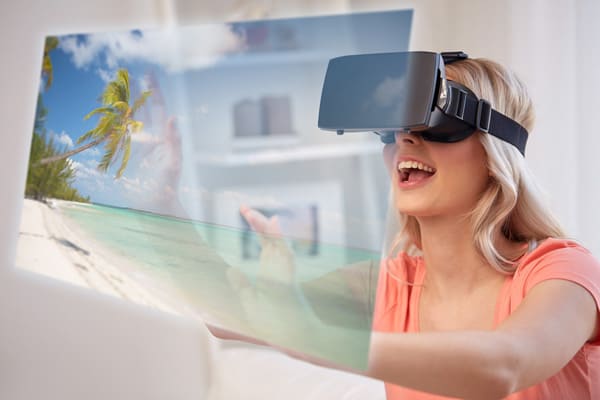
VR created for headsets is more expensive to produce as it requires the production of Stereoscopic content and spatial audio. However, for those travel companies looking to be at the forefront of the technology, the cost can be worth it to allow them to stand out from the crowd and provide an unrivalled experience to their clients.
VR for travel agencies
One of the most common uses of VR headsets in tourism is by the travel agencies themselves. They can offer prospective clients in-store virtual travel experiences that completely transform what it means to visit a travel agency.
Instead of showing visitors brochures and computer screens, travel agents can provide their clients with a virtual experience. This approach can also be used to great effect at trade shows and events, quickly gaining interest from the general public.
Utilising VR allows travel brands to stand out from the crowd and it provides the user with an experience they won’t forget. Many travel companies have embraced VR technology and have used it to improve sales, as well as to gain brand exposure.
Virtual tours of hotels
Virtual hotel tours allow users to explore a hotel and its grounds in a much more immersive way than ever before. Just how virtual tours are transforming the real estate industry, they are also having a huge impact on the hotel industry.
Hotel interiors and exteriors can be captured in extreme detail using high resolution cameras and specialist equipment. The images are then merged together ( stitched ) to form a complete 360 degree interactive tour in which the user can choose which room to explore.
VR hotel tours are usually monoscopic, which means they can be viewed on any device including mobile and desktop. The tours can then be uploaded to websites and social media for prospective clients to view at any time.
They can also be stereoscopic if the situation and budget allows. This can result in a more realistic and immersive experience.
Unlike regular images of hotels, these tours allow users to imagine themselves in the space. This kind of immersion helps to create unique brand engagement and a lasting impression with the user.
To find out more about virtual tours please take a look at our in-depth article here .
VR travel tours
As well as hotels, VR travel tours can also be created for a wide range of travel destinations and landmarks. VR tours of popular tourism destinations can be produced to give the user a taste of what it’s like to be there.
Benefits of virtual reality in tourism
The benefits of virtual reality in tourism include:
- – Allowing the user to imagine themselves at a travel destination
- – Being able to showcase 360 degrees of a destination in high resolution
- – Enabling the user to explore a scene at their own will
- – Creating memorable and unique experiences for the user
- – Creating unique brand engagement
- – Allowing travel companies to stand out from the crowd
- – Providing travel experiences to those that cannot travel
- – Reducing impact of tourism on vulnerable destinations
VR tourism statistics
According to research carried out in Germany by Statista (see below), almost 50% of people would use VR as a tool for choosing their holiday destination (providing it was free). 13% of those surveyed were actually willing to pay for the VR.
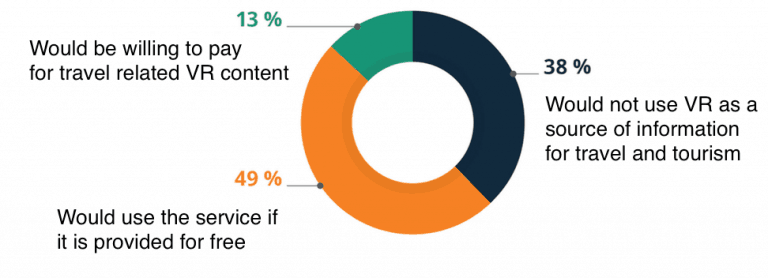
Furthermore, research carried out by Tourism Australia found that almost 20% of consumers had used VR to select a holiday destination. Around 25% of consumers said they planned to use VR in the future to help them decide on a holiday destination.
Overall, the research by Tourism Australia found that VR had the ability to bring a destination to life and make consumers consider travelling to places they wouldn’t have otherwise considered. In particular, consumers were most interested in the VR content that related to nature, wildlife, aquatic, and coastal offerings. – http://www.tourism.australia.com/content/dam/assets/document/1/6/y/7/t/2003897.pdf
The future of VR travel
At Immersion VR, we can’t see tourism VR going anywhere. On the contrary, we have seen an increase in the use of VR for travel. We cannot predict how this space will develop or what new VR travel technologies will be developed. However, we can spot emerging trends within the industry.
VR travel trends
Common VR travel trends include the following:
- – VR travel experiences by travel companies
- – Virtual hotel tours by travel companies and hotels
- – Technologies to make VR travel more realistic
- – VR travel experiences for the elderly
- – VR flight experiences
- – Virtual experiences of landmark destinations
- – Virtual booking interface
We are sure that this list will be growing in the near future so watch this space!
Virtual experiences of landmark destinations
Popular landmark destinations often suffer from the environmental problems associated with too many tourist visitors. By making VR experiences of these landmarks, the number of users can be controlled, reducing the environmental impact.
Take a look below at a VR travel experience of the Grand Canyon. Don’t forget to drag or scroll across the video to explore the scene.
With the number of VR headsets on the increase, these type of experiences are sure to become a common feature in many households across the world.
VR flight experiences
Passengers embark upon a replica of an aeroplane cabin while they are given the pre-flight safety demonstration and then served gourmet food. The goal is to provide them with a realistic experience of flying to a destination.
VR flight experiences are a relatively new addition to the VR travel space. A Tokyo based company called First Airlines has created the world’s first virtual reality airline.
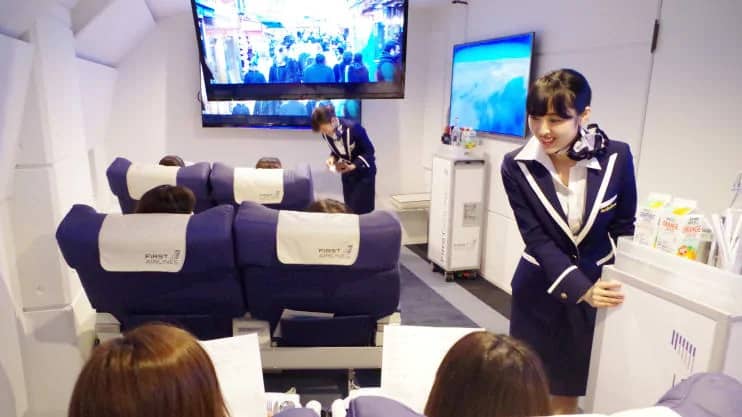
Upon “arrival” the passengers are then given a virtual tour of the destination with VR headsets. Whilst still in its early stages, this kind of experience has the potential to provide people with travel experiences that they would otherwise be unable to afford.
Virtual booking interface
A virtual booking interface is another very recent development within tourism VR. Users can book their holiday whilst wearing a VR headset. All of the booking process takes place within virtual reality.
Everything from choosing the hotel to paying for the holiday happens whilst the user is experiencing the VR. Whilst this has limited applications, we can see travel agencies and companies taking this approach to increase the number of conversions.
It seems to be the logical next step up from one-off travel experiences to taking care of the entire booking process. Whilst still in its infancy, we can see virtual booking interfaces becoming more common within the tourism industry.
Virtual reality travel for seniors
One of the areas in which virtual reality can replace travel is for those that cannot travel, in particular seniors. When people think of VR, they don’t tend to think of the elderly. But being able to provide them with travel experiences that would otherwise not be possible can be extremely rewarding.
In a blog post written by The Big Issue, they explain how a company called Viarama have been working on a VR tool to help people with Alzheimer’s disease and dementia. They worked on providing senior citizens who are receiving end-of-life care with a one-of-a-kind experience.
Billy Agnew, chief executive of Viarama, said:
“In a hospice situation, we are going in there and letting people ‘travel’ the world. We are letting people travel to where they got married, or where they did their national service, and to places that they never thought they would be able to see.” – https://www.bigissue.com/latest/technology/how-virtual-reality-is-giving-the-elderly-remarkable-end-of-life-adventures/
Viarama achieves this by using HTC Vive headsets, Google Earth VR software, and powerful computers. But whilst the experience is virtual, the emotions it elicits are definitely real.
Billy Agnew went on to say:
“It’s quite often hugely moving. The first time we worked in a hospice we had two doctors who were in to evaluate what we were doing, and both of the doctors broke down because it was so emotional.” – https://www.bigissue.com/latest/technology/how-virtual-reality-is-giving-the-elderly-remarkable-end-of-life-adventures/
Will virtual reality replace travel?
VR is great for creating moments of immersion but it cannot yet replace the complete immersion of being in a real space 24/7.
In fact, in a recent study carried out by European touring company Italy4Real, 81% of adults said that VR can’t replace travel. 92% said that visiting a destination in VR did not equate to visiting it in real life. Furthermore, 77% cited sampling the local food as being important to them. – https://www.mediapost.com/publications/article/302947/virtual-reality-not-seen-as-substitute-for-travel.html
Other downsides of VR include smells and the overall atmosphere created by people and animals. Whilst VR technology is progressing at a fast rate, it’s pretty safe to say that virtual reality won’t be replacing travel anytime soon.

VR in tourism is currently best used for marketing travel destinations and hotels. With the growth of VR, we think that virtual travel experiences will become a huge part of the tourism industry in the near future.
VR travel experts
At Immersion VR we have a wealth of experience in VR for travel with clients across the UK and overseas. We have shot on location in countries such as Oman, Scotland, Spain, Indonesia, and Mexico.
We can cater for any kind of tourism VR that you need, from virtual reality travel experiences to VR hotel tours.
We take great pride in the quality of our work and we are unlike any VR travel company. With skills in so many areas of VR, we can advise and inform our clients every step of the way.
Our highly trained crew and attention to detail is what puts us amongst the best VR travel experts out there.
For more information on VR for travel and the services we offer please get in touch today.
Contact Form
You can email us at [email protected] . Alternatively, you can fill in our contact form below and we will get back to you as soon as possible.
By clicking Submit, you are agreeing with our Privacy Policy . We will not share, trade, sell, deliver, reveal, publicise, or market your personal details in any way.
Get In Touch
We are 360 VR specialists
- Get One: Tornado Alert Apps
- The Best Tech Gifts Under $100
7 Great Virtual Reality Travel Experiences
Try VR travel to fulfill your bucket list without leaving the couch
:max_bytes(150000):strip_icc():format(webp)/AndyODonnell-8caf48b630264ce790c410f0499a206c.jpg)
- Auburn University
:max_bytes(150000):strip_icc():format(webp)/GlamProfile-7bfa34647d8e4c8e82097cc1daf8f5ec.jpeg)
- Saint Mary-of-the-Woods College
- Electric Vehicles
- Working From Home
- Headphones & Ear Buds
- Smart Watches & Wearables
- Travel Tech
- Connected Car Tech
- iPods & MP3 Players
Who says you can't see the world if you stay home? Virtual reality (VR) tourism experiences let you see places all over the world without ever leaving your couch. These aren't games; they're experiences, so the pace may be slower than you expect, but they are worth your patience. Here are some of the best VR tourist destinations to help you decide on your next virtual adventure.
Make sure your computer is beefy enough to handle the demands of virtual reality technology.
The Grand Canyon VR Experience
Very relaxing experience.
Excellent visual and sound quality.
Impressive attention to detail.
Predefined with little control.
Requires powerful hardware.
Short experience.
In The Grand Canyon VR Experience ($2.99 by Immersive Entertainment), you sit in a virtual motorized kayak ride through the Grand Canyon. Tailor the tour to your preferences by selecting either a sunlit or moonlit experience and controlling the ride's speed.
While you cruise along, you'll enjoy the sights and sounds of procedurally generated, artificially intelligent wildlife. Attract and feed the virtual fish as you navigate the waterways.
The ride is on rails, so you can't steer the kayak. However, you can stop at various points and enjoy the scenery by using the throttle speed controls of your motorized kayak or by exiting at scenic rest stops.
The tour is short, and there's no historical background information for history buffs. Still, it is a fun ride perfect for someone new to VR.
This tour requires one of the following virtual reality headsets: HTC Vive, Oculus Rift , or Valve Index .
Explore amazing places.
Impressively detailed.
More locations are added to the library regularly.
Not updated recently.
Realities (free from Realities.io ) is a VR travel app that allows you to explore scanned and modeled real-world environments. The environments aren't just 360-degree photos; these locations were captured with specialized scanning equipment, allowing for immersive rendering in virtual reality.
The user interface is a giant globe you rotate with your VR controllers. Once you decide on the place you want to visit, tap the area on the virtual globe, and you are instantly whisked away to the exotic locale.
One interesting destination is a cell in the infamous Alcatraz prison. When you arrive, you're greeted by an unseen narrator, presumably a former prisoner in the cell next to you, who recalls their experiences. It's museum-like and an educational adventure worth having.
There are other destinations of varying size and complexity, and the experience is updated with new realities regularly.
This experience is compatible with the HTC Vive, Oculus Rift, Valve Index, and Windows Mixed Reality .
Titans of Space PLUS
Great soundtrack.
Detailed 3D visuals.
Impressive sense of scale.
Flying through space makes some users feel nauseated.
No improvements since late 2019.
Do you like planetariums? Have you always wished they were more realistic? If you've ever dreamed of riding in a spaceship and exploring the solar system and beyond, Titans of Space PLUS ($9.99 by DrashVR LLC) helps make this a reality—at least a virtual one).
The original Titans of Space was one of the first polished virtual reality experiences available; it created a lot of buzz about all the potential VR had to offer.
This app provides a theme park-style ride through the solar system and beyond, allowing you to control the pace of the experience. Factoids about the planets and moons are provided throughout your journey, as are distances and other measurements of interest.
The sense of scale of the planets and moons is truly awe-inspiring and gives a unique perspective only astronauts usually get to have.
This title runs in both standard and VR modes. It does not require a VR headset. It is compatible with HTC Vive, Oculus Rift, Valve Index, and Windows Mixed Reality.
Impressive rendering technology.
Auto-tunes for your GPU.
Stunning visuals.
Can feel slow.
Mostly narration with little hands-on time.
Everest VR ($9.99 from Sólfar Studios ) is an interactive Mount Everest VR tourism experience.
You'll experience Mount Everest in five iconic scenes. Prepare for your expedition at Basecamp, traverse the terrifying Khumbu Icefalls, spend the night at Camp 4, ascend the perilous Hillary Step, and finally conquer the summit of Everest.
After completing your first summit attempt, unlock God Mode to reach a unique vantage point of the Himalayas that's only possible in VR. Towering over the mountain range, this is a stunning VR diorama.
EVEREST VR is a must if you're into mountain climbing but don't like its possible death and frostbite aspects.
Requires one of the following virtual reality headsets: HTC Vive, Oculus Rift, or Valve Index.
The VR Museum of Fine Art
Lots of content.
Educational experience.
Hasn't been updated since its initial release.
No voice narration.
Only takes about 20 minutes to experience.
If you've ever wanted to peruse a museum at your own pace with no limits on how close you can get to the artwork, then The VR Museum of Fine Art (free from Finn Sinclair) is for you.
This free app holds amazing educational value with incredibly detailed scans of some of the world's most famous paintings and sculptures. Look at the brushstrokes of Monet's Water Lilies or take a 360-degree tour of Michelangelo's David. This is an art lover's delight.
The experience makes you feel as if you're visiting a museum, complete with a pamphlet map to help you navigate your way around the exhibits.
Great VR experience.
Incredibly realistic.
Contains three episodes.
theBlu ($9.99 from Wevr INC .) is a collection of virtual reality-based underwater experiences that make you feel as if you're literally in the tank of a huge aquarium exhibit.
Stand on the deck of a sunken ship while a gargantuan whale swims by and looks you straight in the eye or swim in a sea of bioluminescent jellyfish. There's no need for expensive scuba equipment or diving classes, or even to leave your living room, for that matter.
The level of detail in this app is amazing, and the sense of scale (especially during the whale encounter in the first episode) is jaw-dropping.
Compatible with HTC Vive, Oculus Rift, Valve Index, and Windows Mixed Reality.
Google Earth VR
Amazing street view VR.
Travel the world virtually.
Impressive, vast experience.
Can be slow to load.
Lacks a search feature.
May cause motion sickness.
When Google Earth was released many years ago, everyone marveled at the novelty of finding and viewing their house from satellite imagery. Now, Google Earth VR (free from Google) lets you see your house from space and virtually fly to it and stand in your front yard or on your rooftop.
Change the sun's position, scale objects to any size you like, and fly around the world. The detail levels depend on what you're trying to view. For example, tourist destinations are likely to have more detailed geospatial imagery than rural areas. There is so much to see, and Google offers virtual tours to help you get started.
Google has even added several comfort features to prevent virtual travel sickness in this must-see virtual reality app.
Get the Latest Tech News Delivered Every Day
- The 8 Best Free VR Games of 2024
- The 15 Best Minecraft Mods
- The 10 Best Scary Virtual Reality Games
- The Best VR Apps for the iPhone in 2024
- The 19 Best Free Virtual Field Trips of 2024
- The 9 Best VR Workout Games
- The 10 Best VR Puzzle and Escape Room Games
- The 10 Best Virtual Reality Games For Kids
- 5 Things to Consider Before Buying a VR Headset
- What Is Mixed Reality?
- How to Check If Your PC Is VR Ready
- The 6 Best Virtual Reality Movies to Watch (2024)
- What Is an Immersive Experience?
- Everything You Need to Know About Virtual Reality on iPhone
- Valve Index Review
- How to Avoid Virtual Reality Sickness
- International edition
- Australia edition
- Europe edition

Virtual reality tourism ready for takeoff as travellers remain grounded
Experts say pandemic could provide watershed moment for technology, potentially leading to more sustainable tourism
With globe-trotting banned in the pandemic, increasing numbers of people are turning to virtual reality to relieve pent-up demand for travel.
Escapism from the sofa through a growing range of VR travel experiences is whetting appetites for post-pandemic holidays and could be a watershed moment for the technology in tourism, say analysts.
“As long as the pandemic increases and we are spending more time indoors, we should see adoption keep on growing,” said Ralph Hollister, a tourism analyst at Global Data and the author of a recent report on VR in tourism.
Oculus launched its Quest 2 headset in October and the most popular experiences include National Geographic VR, which takes users to places such as Antarctica – where they can navigate icebergs in a kayak, climb an ice shelf and survive a raging snowstorm as they search for a lost emperor penguin colony.
Another app, Wander, can teleport VR travellers from the pyramids of Egypt to the gardens of the Taj Mahal, while Alcove offers immersive experiences from hot air balloon rides to city tours.
When We Stayed Home takes travellers to the heart of Paris, Venice, Jerusalem and Tokyo as they largely are today. Through the eyes of a local, you can witness the calm, the beauty and the emptiness of a places on pause during April 2020.
“In this time of social distancing, people are looking for different ways to stay entertained, connected and active, and VR offers that,” said an Oculus spokesperson. “Whether you want to transport yourself to different places in the world, play with friends, get fit or just hang out together and feel like you’re in the same room, people are realising they can with VR.”
One prominent adopter of pandemic VR is Germany’s national tourist board, which has unveiled a number of immersive projects. The Maldives Marketing and Public Relations Corporation is using VR to showcase experiences such as beach yoga and snorkelling.
Hollister said VR was still seen as a gimmick. “It remains to be seen if increased usage will last beyond when meaningful travel resumes.” But he believes it could.
“I think the increase will be sustained, especially with the Gen Z and millennials in coming years, as they move into higher-paid jobs, and marketers take them more seriously as a consumer group. They will not feel alienated by the technology,” he said.
Currently, VR is used in the pre-trip “dreamer” stage in tourism, with people looking at where they might want to go. Among the tourist operator Kuoni’s offerings, potential customers can take a 360-degree tour of the upmarket Sandy Lane luxury resort in Barbados.
Hollister predicts that in the future people could use VR to book trips directly, as well as choosing seats on planes and hotel rooms with a click of the controller.
“A lot of travellers and consumers want a seamless experience, to go from looking to booking with minimal clicks, instant gratification and saving as much time as possible,” he said.
It has its limitations. ‘Tourism is also about touch, taste, smell, all those other sensory experiences, which is something VR cannot do,” he said. The price of high-quality headsets restricts access too.
But as the world seeks more sustainable tourism, Hollister said VR also offered a solution. As historic sites are damaged through mass tourism, recreating them in VR could help conserve them.
So this could be a watershed moment for VR and travel. “Everyone will be analysing that and working out its real worth to the industry,” he said.
‘More immersive than I could have imagined’
Angel Ross hoped to be travelling this year – and he has. He’s been cage diving with white sharks, kayaked in Antarctica and played poker in China – all virtually.
Ross, who works for a London-based marketing firm, invested in an Oculus Quest 2 in January to satisfy his wanderlust after finding himself “stuck at home with the winter getting a bit depressing”.
He said: “I love travelling. I am 22 and these are the years when I have been wanting to do a lot of things, and obviously can’t do anything right now. I love the ocean and I love snorkelling. On the Oculus you can dive with all these different animals, and it’s super immersive and realistic.
“There’s a great white shark, you can get in a cage and it comes up to you. It was pretty terrifying but amazing. Then there’s more friendly animals like dolphins you can play with. I’ve done all of them, pretty much.”
To make it more inclusive, he can cast what he is seeing on to his computer or TV to share with friends. “You feel quite disorientated when you come out, because you are really tricking your brain to think you are there,” he said.
On the National Geographic VR app, he went on an Antarctic adventure. “I saw whales, I was in a kayak and you can climb an ice shelf. You really feel like you are walking and moving and going somewhere. All your senses – obviously not smell and touch – feel they are being completely absorbed.
“I am a big poker player, with friends and not for money. And the poker on there is incredible. You can go to all these different locations. And one is this Chinese rooftop garden pool. Really cool.”
He has also been rock climbing in the Alps, “which is super realistic – you chalk your hands and you can look around and see the drop. Pretty insane.”
On YouTube VR he went in a drone up to 40,000ft to see the curvature of the Earth. “It’s even more immersive than I could have imagined. One hundred per cent,” he said .
“Because it’s so immersive and intense, you can’t sit on it for hours on end. You need breaks. So you can have an intense, fun experience and do so many different things, invigorate your senses. And then you just stop, have a break. And you don’t need that constant fix.”
- Virtual reality
- Travel & leisure

Apple Vision Pro reviews roundup: stunning potential with big trade-offs

Apple reveals Vision Pro AR headset at its worldwide developers conference

Can we create a moral metaverse?
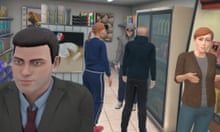
VR role-play therapy helps people with agoraphobia, finds study
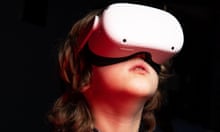
UK data watchdog seeks talks with Meta over child protection concerns

VR worlds are no better or worse than anywhere else online

Matrix effects, routes on your specs: what next for augmented reality?
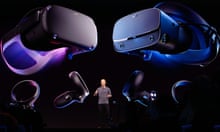
Facebook sets out plan for 'effortless' virtual reality socialising
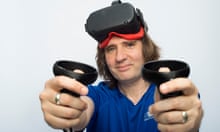
Can virtual reality really get you fit?
Most viewed.
Benefits of Virtual Reality in the Tourism and Travel industry
- VR for Tourism
Virtual Reality is transforming the travel and tourism industry in an unstoppable way! VR can create amazing experiences limited only by your imagination. It is an excellent tool for marketing hotel rooms, flights, and travel products. As a hotel or travel company, you can provide unique customer experiences with VR elements on your website or as app downloads.
Support customer buying decisions and give insights before booking a hotel
The primary benefit of Virtual Reality in the tourism and travel industry is to initially provide a kind of ‘try before you buy’ option. The immersive nature of VR enables everyone to experience a virtual version of a hotel room, attraction, or unique selling point. VR can cause strong emotions more convincingly than just viewing images or reading customer reviews can achieve. Because customers usually require lots of information before they book a hotel room, you can significantly shorten the process of researching and seeking information by using VR. VR experiences offer an effective way to show customers how their stay could look like, and give them confidence that they are dealing with a honest vendor with nothing to hide, before arriving at a purchase decision.
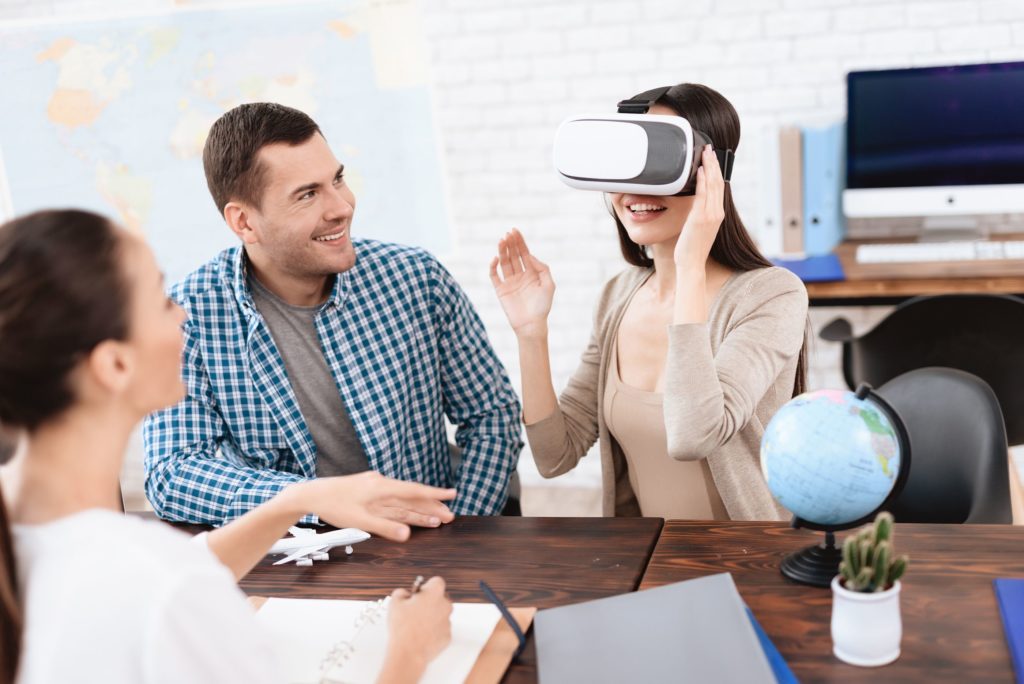
Create a VR experience from your local attractions to increase publicity
The big-hitting tourist destinations dominate the tourism market, leaving marketers of smaller or less famous attractions a hard time in competing.
VR helps to attract a large audience of visitors to see a destination’s potential and to show how worthy it is to visit. An attention-grabbing, immersive VR experience has exponentially greater impact on increasing visitor intention than traditional media, and at relatively small cost.
Alternatively, you might not want hordes of visitors descending on a place that is literally crumbling under the mass of tourists. Or some environmentally sensitive destinations will have unique ecosystems in danger from human intrusion. Or a destination might just be too expensive for most people to reach. In these cases, VR can provide a satisfying substitute for the real experience.
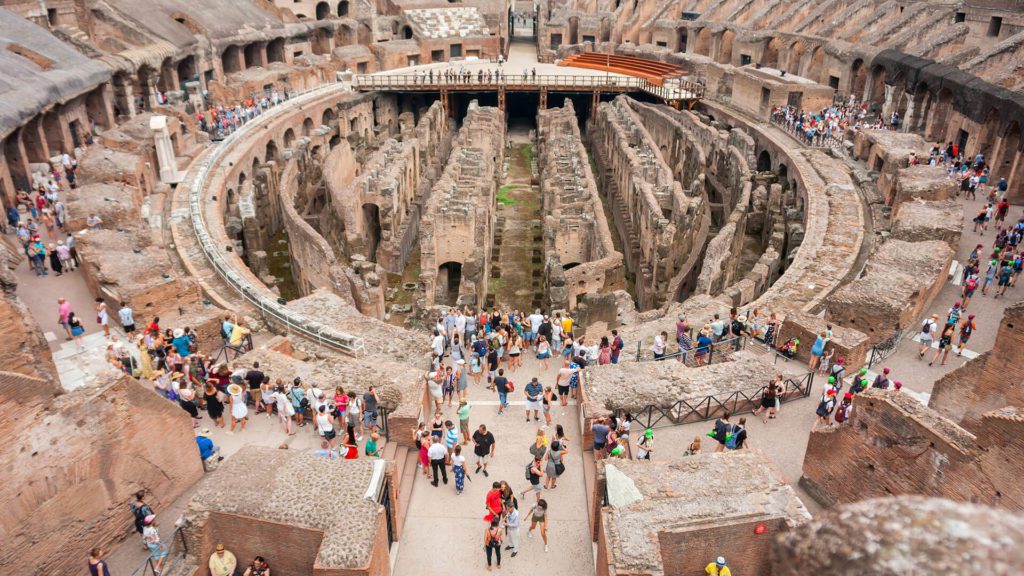
Become an innovation leader in the tourism industry
Make VR valuable in your area of tourism and travel and be amongst the first to emotionally empower your customers with the help of VR. Typically, tourist customers seek to purchase experiences rather than products, and Virtual Reality offers a great way to provide a completely new customer journey that takes in all the senses. thereby creating maximum customer value. You can diversify your services, meet the demands of the market – and be an innovative leader of your industry. Be aware also that Millennials and upcoming Generation Z customers already spend a lot of time in digital environments and are therefore the perfect target group for digital technologies.
What our partners and clients say
VRdirect enables businesses to easily create their own Virtual Reality projects and to make them available to end-users, employees or partners. Everything without having to develop their own app and without the need of any expert skills. Read how our partners and clients are already using it profitably:

„Virtual Reality for Tourism – it is very obvious that the medium offers great possibilities. Buying decisions are often emotional ones and VR again is perfect to support this. At the same time, we always want to offer our clients marketing ideas that are reasonable within a more complex strategy and a step ahead of the competitors. With VRdirect as a proven platform, we can quickly implement our creative ideas in this area and provide our clients with very professional, stable and cost efficient Virtual Reality projects (VR apps and Web Player solutions).”
Stefan Thomsen Managing Partner at Travel Marketeers
“Virtual Reality / Interactive 360° is a key medium when it comes to tourism and city marketing. Successfully working with hotels, cultural institutions and tourism authorities in Germany and also Spain, edataconsulting is alwaysexploring possibilities in how to add “virtual value” to a campaign. From our experience VR does significantly support the sales process and as an emotional medium can really drive purchase decisions. Our mission is to enable all of our clients to exploit the great potential of Virtual Reality – by offering efficient, scalable and still very stable solutions. As experts in 360° production and marketing we can fully rely on VRdirect here. By using the platform to build and distribute our projects we are saving clients the enormous costs of programming.”
Carlos Ayala Jiménez Head of Sales at edataconsulting

Are you keen to learn more about working with Virtual Reality in the tourism and travel industry?
Download our White Paper for an in-depth view on the various benefits of VR for the tourism and travel industry , as well as a step-by-step guide for how to create your own interactive experience. Learn how to use VR to increase hotel bookings and get to know more about future trends in travel marketing.
Virtual Reality is exploding all over the tourism industry, and as a stakeholder and player you cannot escape its impact!

The VRdirect platform is the easiest solution to create and publish Virtual Reality projects. There are no expert skills needed. Moreover, Virtual Reality projects created with VRdirect can be published instantly via any VR enabled device, smartphone or web-browser and you can update them easily and in real-time.
- VRdirect Products & News
- VR in Healthcare
- VR Hardware & Content Production
- VR for Training & HR
- VR for Real Estate
- VR for Marketing & Sales
- VR for Events
- VR for Agencies
- Metaverse-Update
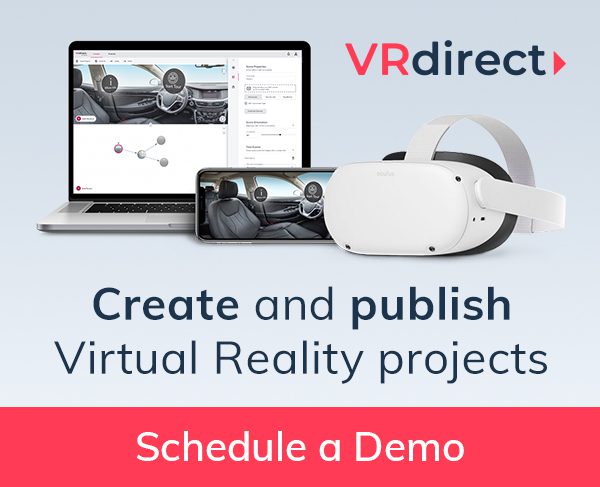
Download On

© 2023 VRdirect GmbH. All rights reserved.
CSK won by 78 runs
WI Women won by 7 wickets (with 10 balls remaining)
RCB won by 9 wickets (with 24 balls remaining)
IND Women won by 44 runs
Sri Lanka A won by 8 runs (DLS method)
W. Indies A won by 10 runs
Day 3 - Essex trail by 44 runs.
Day 3 - Hampshire trail by 92 runs.
Day 3 - Warwickshire trail by 225 runs.
Day 3 - Somerset trail by 137 runs.
Day 3 - Middlesex lead by 143 runs.
Day 3 - Leics trail by 356 runs.
Day 3 - Derbyshire trail by 260 runs.
Kolkata Knight Riders
Delhi Capitals
Match yet to begin
Scotland Women
United States of America Women
Ireland Women
Zimbabwe Women
Thailand Women
Uganda Women
United Arab Emirates Women
Netherlands Women
Sri Lanka A vs AFG A , 4th unofficial ODI at Hambantota , SL vs AFG [A-Team] , May 05 2024 - Live Cricket Score

IMAGES
VIDEO
COMMENTS
Vr Tourism is an innovative startup operating in the field of creative culture. In particular, he works on digitizing the cultural offerings of villages and museums through the use of immersive technologies. The digital offering produced is made available through the use of a vr box set patented and produced by it. The museum, once...
VR TOURISM S.R.L. DATI DELLA SOCIETÀ - VR TOURISM S.R.L. Partita IVA: 03040580593 - Codice Fiscale: 03040580593; Rag. ... Società sottoposta a direzione e controllo della Open Holding Srl Viale Filippo Tommaso Marinetti 221 - 00143 Roma REA 1378273 Cap. Soc. € 50.000,00 i.v. - P.I. IT12485671007 - CODICE DESTINATARIO 'USAL8PV' ...
vr tourism srl. d&b business directory home / business directory / information / publishing industries / newspaper, periodical, book, and directory publishers / italy / caserta / sessa aurunca / vr tourism srl; vr tourism srl. get a d&b hoovers free trial. overview
In 2024, Statista reported a 30% increase in VR tourism adoption, highlighting its growing popularity. Gartner predicts that by 2025, 50% of global travel agencies will use VR for showcasing destinations. According to SEMrush, searches for VR travel experiences rose by 40% in the past year, indicating rising consumer interest. Sustainable ...
Find company research, competitor information, contact details & financial data for VR TOURISM SRL of FORMIA, LATINA. Get the latest business insights from Dun & Bradstreet. VR TOURISM SRL. D&B Business Directory HOME / BUSINESS DIRECTORY / INFORMATION / PUBLISHING INDUSTRIES / NEWSPAPER, PERIODICAL, BOOK, AND DIRECTORY PUBLISHERS
Vr Tourism è una startup che opera nel settore culturale e creativo. Digitalizza l'offerta turistica culturale dei borghi mediante l'uso di tecnologie immersive vr, che viene distribuita fisicamente mediante un cardboard vr proprietario. L'attività è stata validata ed è sul mercato dal 2023.
See full page Connect to Vr Tourism srl people. Track new updates like investors and funding Get the latest on product, customer and other traction It's all free - F6S is the largest tech company network globally Vr Tourism srl. Vr Tourism è una startup che opera nel settore turistico culturale. Sports ...
STAND A56 Vr Tourism è una startup innovativa che opera nell'ambito della cultura creativa. In particolare si occupa di digitalizzare l'offerta culturale di borghi e musei attraverso l'uso di tecnologie immersive. L'offerta digitale prodotta viene resa disponibile grazie all'uso di un cofanetto vr da essa brevettata e prodotta. Il museo, una volta ricevuto il...
VR TOURISM SRL. Aggiornato: 20/06/2019 Solution provider Vr Tourism è una startup innovativa che intende entrare nel mercato dei gift box turistico-esperienziali e dell'editoria digitale. Contenuti correlati: Persone: Alfonso Consalvo. Sito web: https://www ...
Introduction. Virtual reality (VR) tourism (e.g. M. J. Kim et al., Citation 2020), also called 'VR travel', is a technology-driven mode of travel that provides tourists with virtual experiences through a three-dimensional environment created using computer technology (Guttentag, Citation 2010).VR tourism allows tourists to experience a destination virtually without travelling physically to the ...
Virtual Reality (VR) allows users to experience simulated environments as if they're in the real world. With VR, you could experience far-off destinations' sights, sounds, and sensations without ever getting on a plane. VR tourism has been gaining popularity in recent years, offering tourists an immersive and accessible way to explore the world.
IMMERSE YOURSELF IN ANTIQUITY WITH AUGMENTED REALITY TOURS Enjoy the best exciting and engaging experience suitable for everyone Visit the archaeological sites of Pompeii, Herculaneum and the main Neapolitan museums, with our AR Glasses: cutting-edge technology that allows you to admire, superimposed on the ruins, the reconstructions of buildings, interiors and archaeological finds. With AR ...
First Airlines is often described as the first virtual airline. It takes VR tourism to the next level by mixing real-world and digital simulations to create a fully immersive experience. People board a perfect recreation of an A310's cabin. The recreation even uses authentic seats from decommissioned planes.
Vr Tourism srl La 1° piattaforma in grado di visite guidate in streaming live vr museuminbox Digitalizza l'offerta turistica culturale italiana in modalità immersiva vr Beeyondgames Opera nella digitalizzazione e ludicizzazione del turismo culturale 4.0 VIRTUR Interactive virtual tours for museums mARc project s.r.l. innovazione applicata al ...
Virtual and Augmented reality are generally known for their consumers' applications, like gaming, but most VR/AR market revenues come from business applications. In our VR Roadshow, we let people experience how they can use Virtual Reality to collaborate with colleagues using shared spaces and avatars like they were in the same room, even if ...
The purpose of this paper is to provide an insight as to how recent trends in virtual reality (VR) have changed the way tourism and hospitality industry communicates their offerings and meets the tourists' needs.,The approach is based on systematic literature review, where the relations between focal concepts are given to analyze potential ...
2. Detailed Destination Showcase. One of the key advantages of VR in tourism is its ability to showcase destinations in stunning detail. Through high-resolution, 360-degree views, users can explore every angle of a destination, providing them with a comprehensive understanding of what it has to offer. 3.
The benefits of virtual reality in tourism include: - Allowing the user to imagine themselves at a travel destination. - Being able to showcase 360 degrees of a destination in high resolution. - Enabling the user to explore a scene at their own will. - Creating memorable and unique experiences for the user.
In The Grand Canyon VR Experience ($2.99 by Immersive Entertainment), you sit in a virtual motorized kayak ride through the Grand Canyon. Tailor the tour to your preferences by selecting either a sunlit or moonlit experience and controlling the ride's speed. While you cruise along, you'll enjoy the sights and sounds of procedurally generated ...
Escapism from the sofa through a growing range of VR travel experiences is whetting appetites for post-pandemic holidays and could be a watershed moment for the technology in tourism, say analysts.
Abstract and Figures. Purpose Emerging technologies, such as virtual reality (VR), have been influencing both the tourism supply side and tourists alike. The purpose of this study is to analyse VR ...
The primary benefit of Virtual Reality in the tourism and travel industry is to initially provide a kind of 'try before you buy' option. The immersive nature of VR enables everyone to experience a virtual version of a hotel room, attraction, or unique selling point. VR can cause strong emotions more convincingly than just viewing images or ...
Sri Lanka A vs Afghanistan A live cricket score, SL vs AFG [A-Team] 2024, 4th unofficial ODI at Mahinda Rajapaksa International Cricket Stadium, Sooriyawewa, Hambantota. Get live score, ball by ...
Sir Mick, 80, is seen with a VR headset to explore the moon virtually, with a spacecraft simulator and with the astronauts. The weekend concert is the first in a 16-city tour of the US and Canada ...